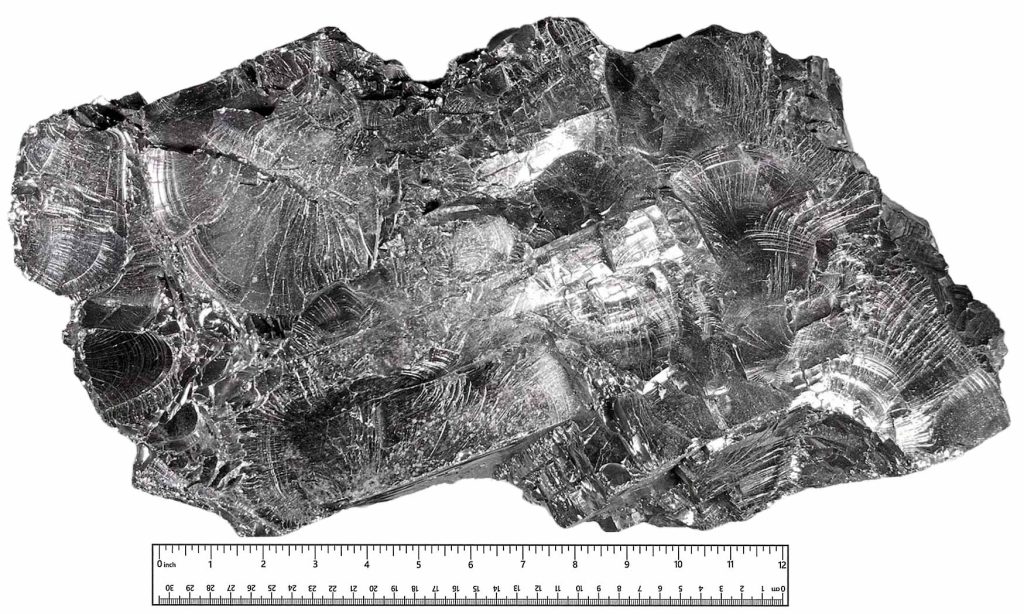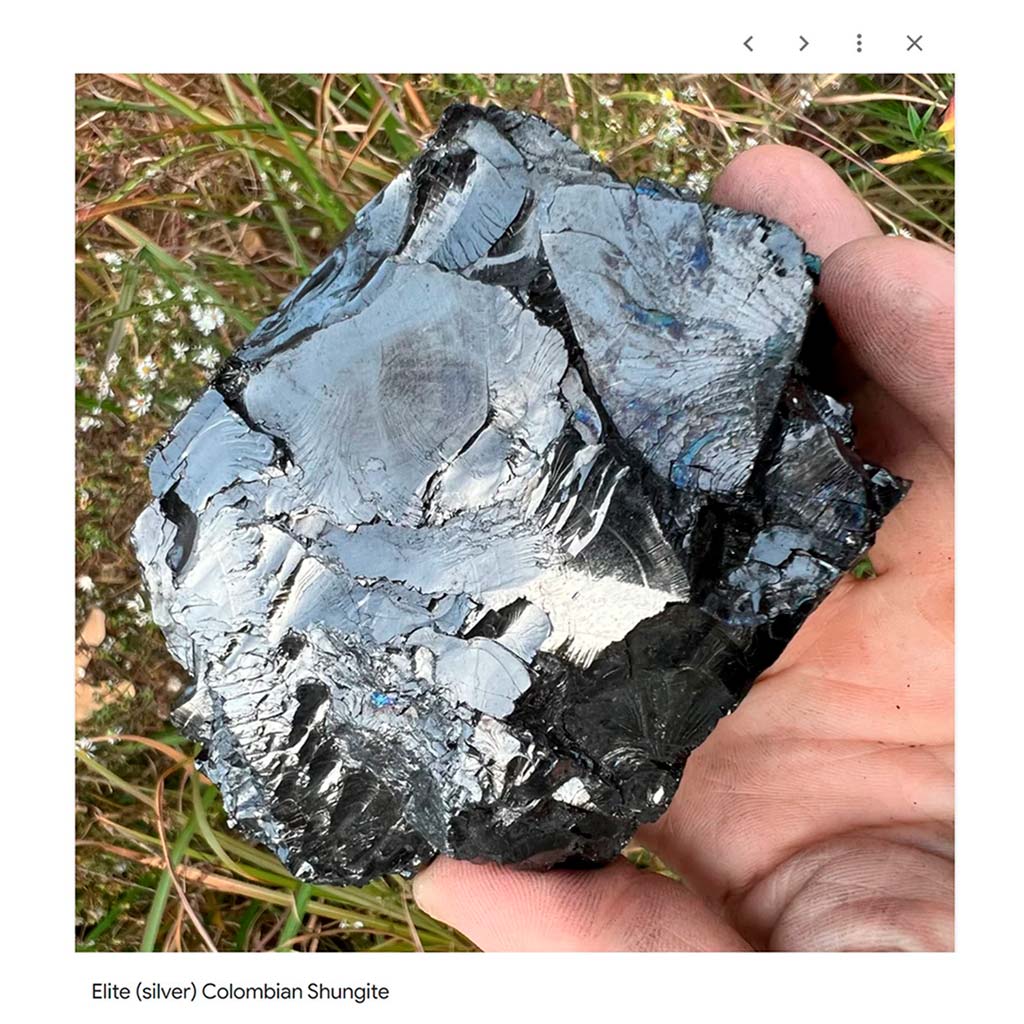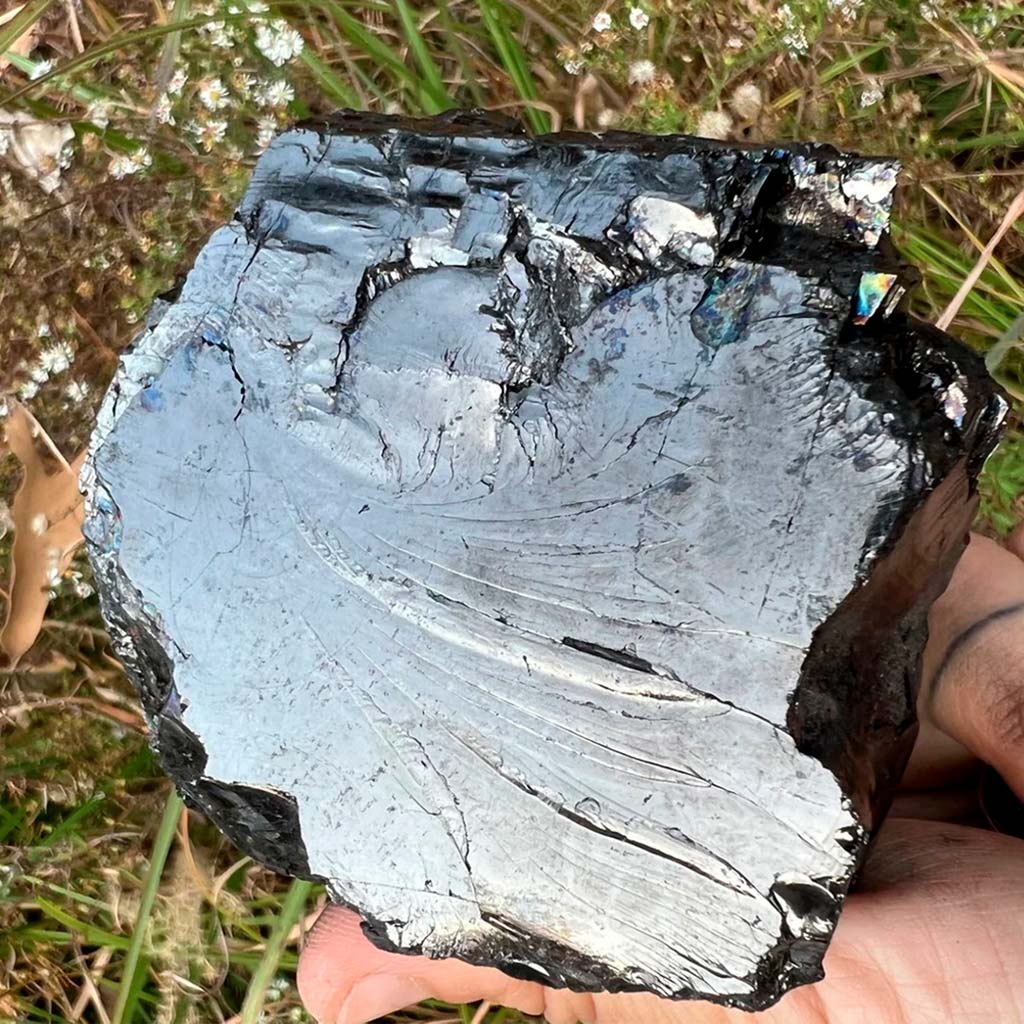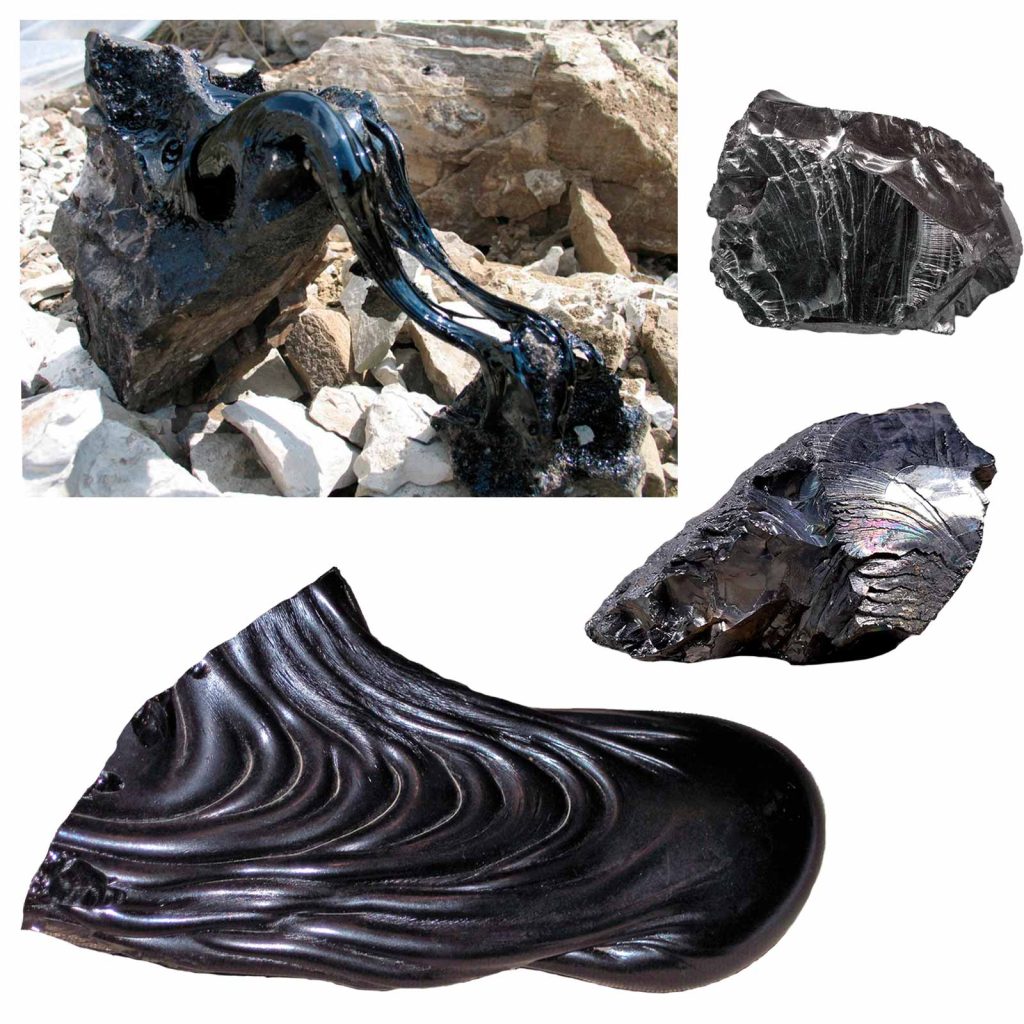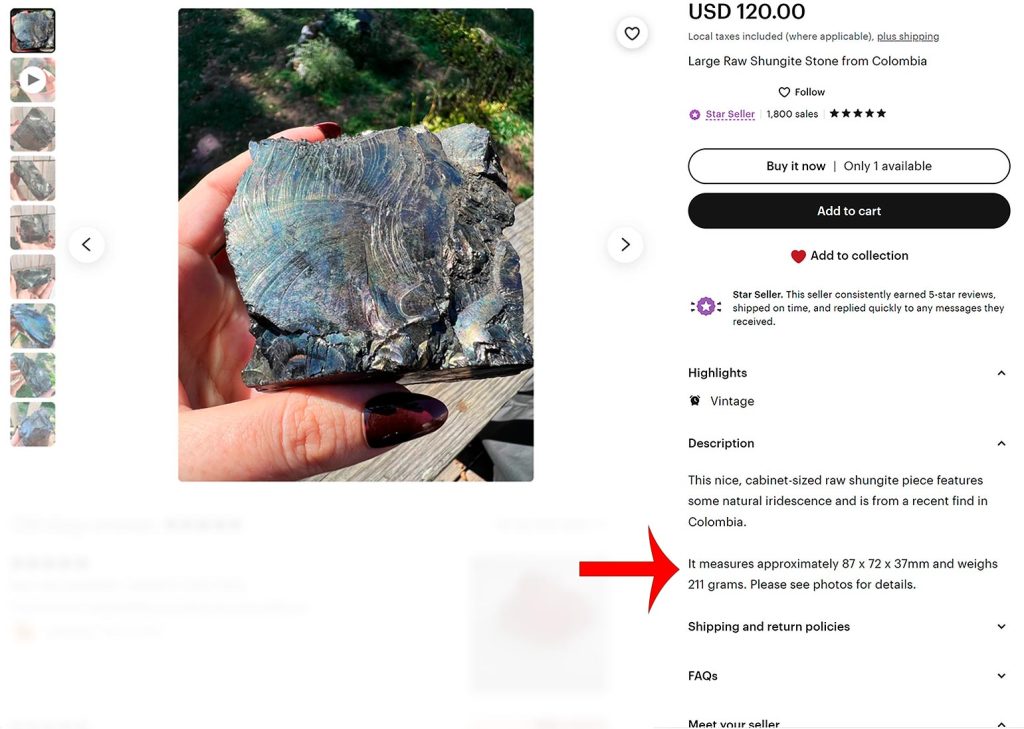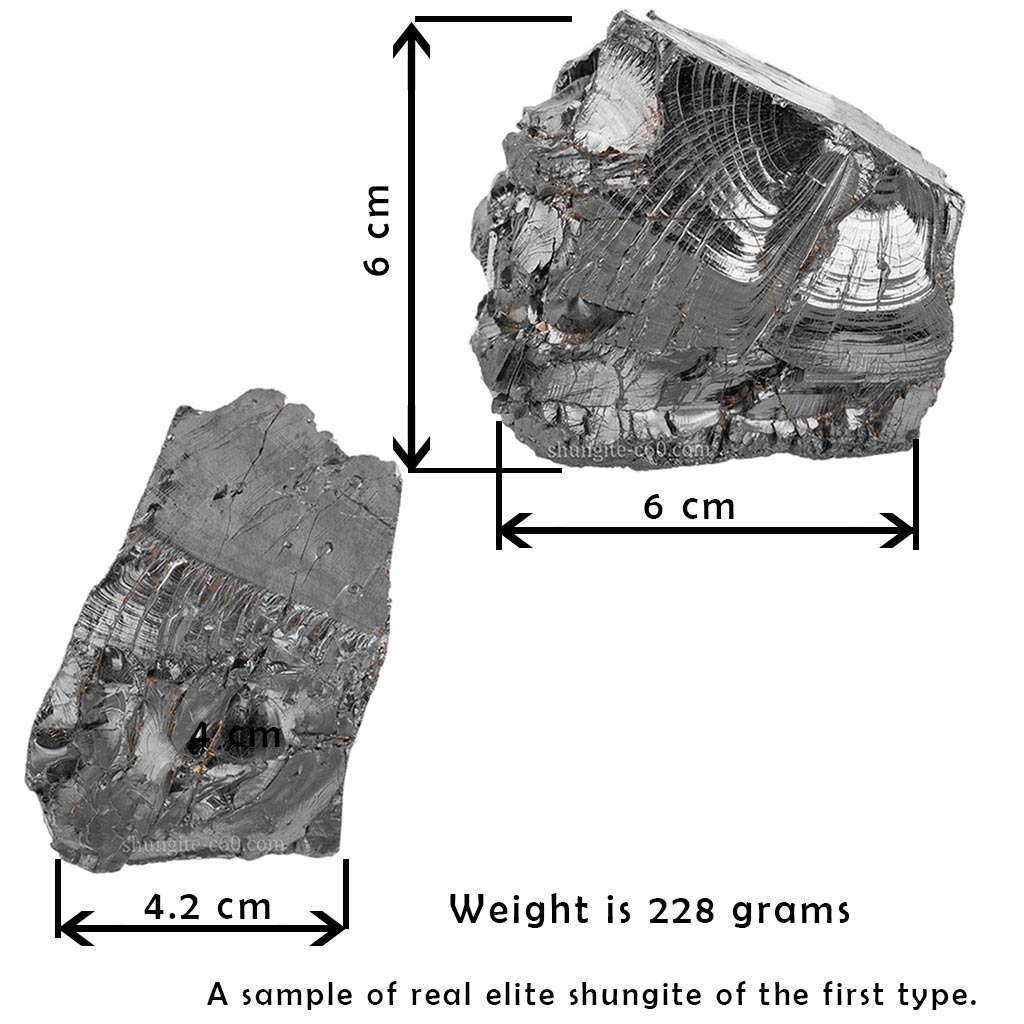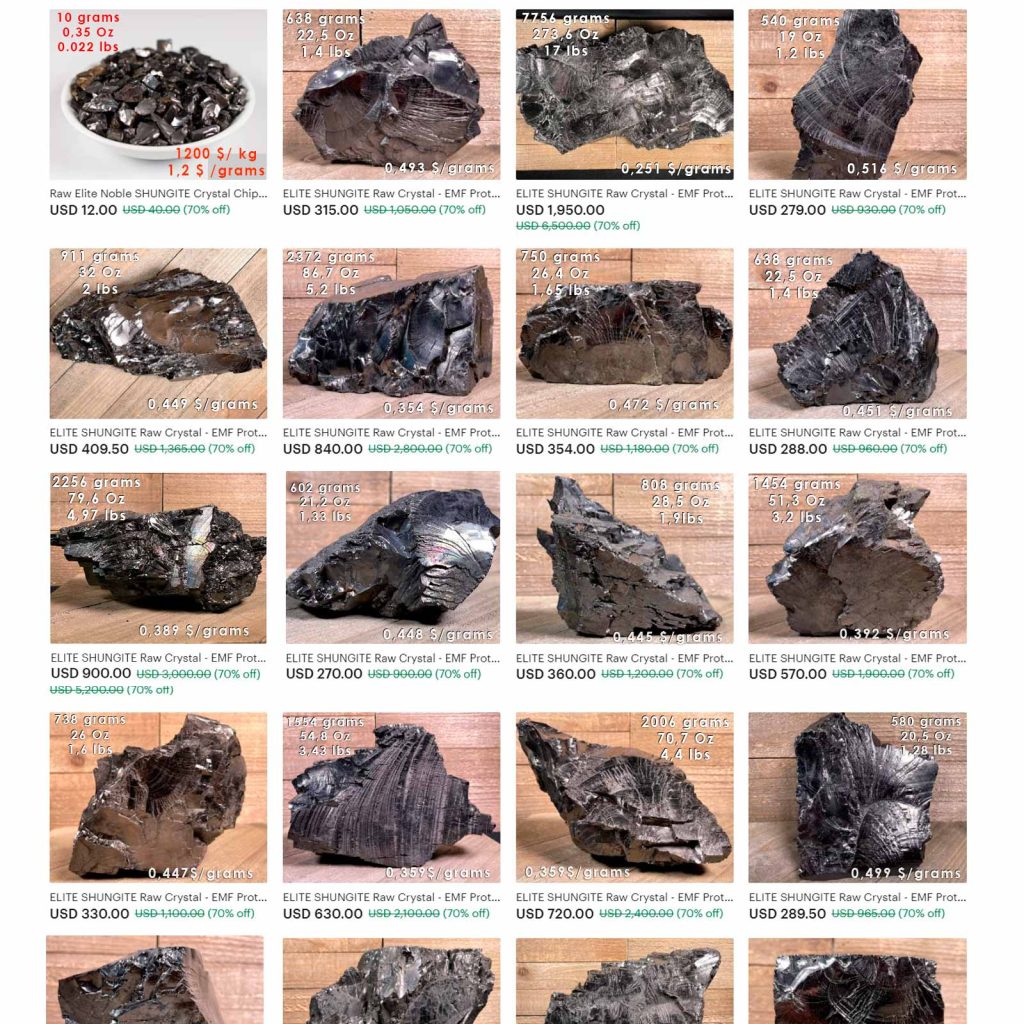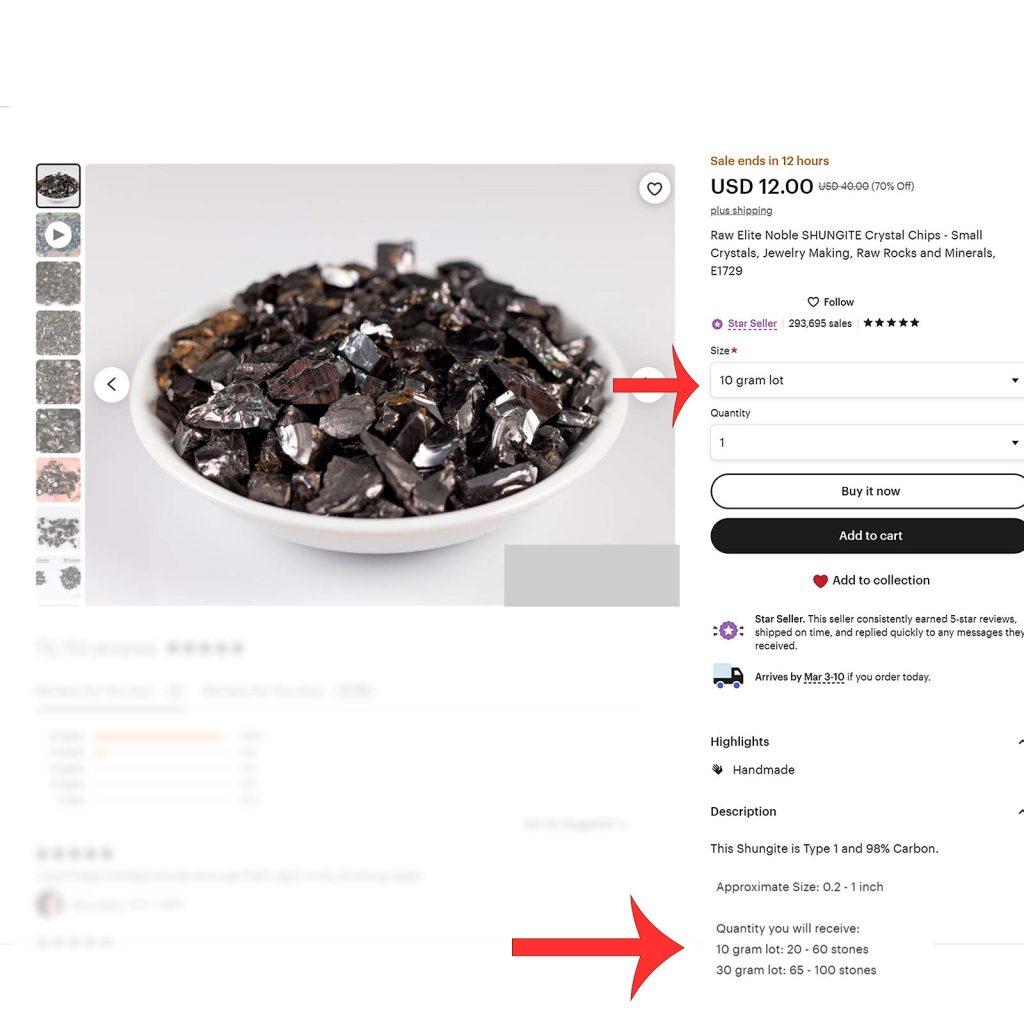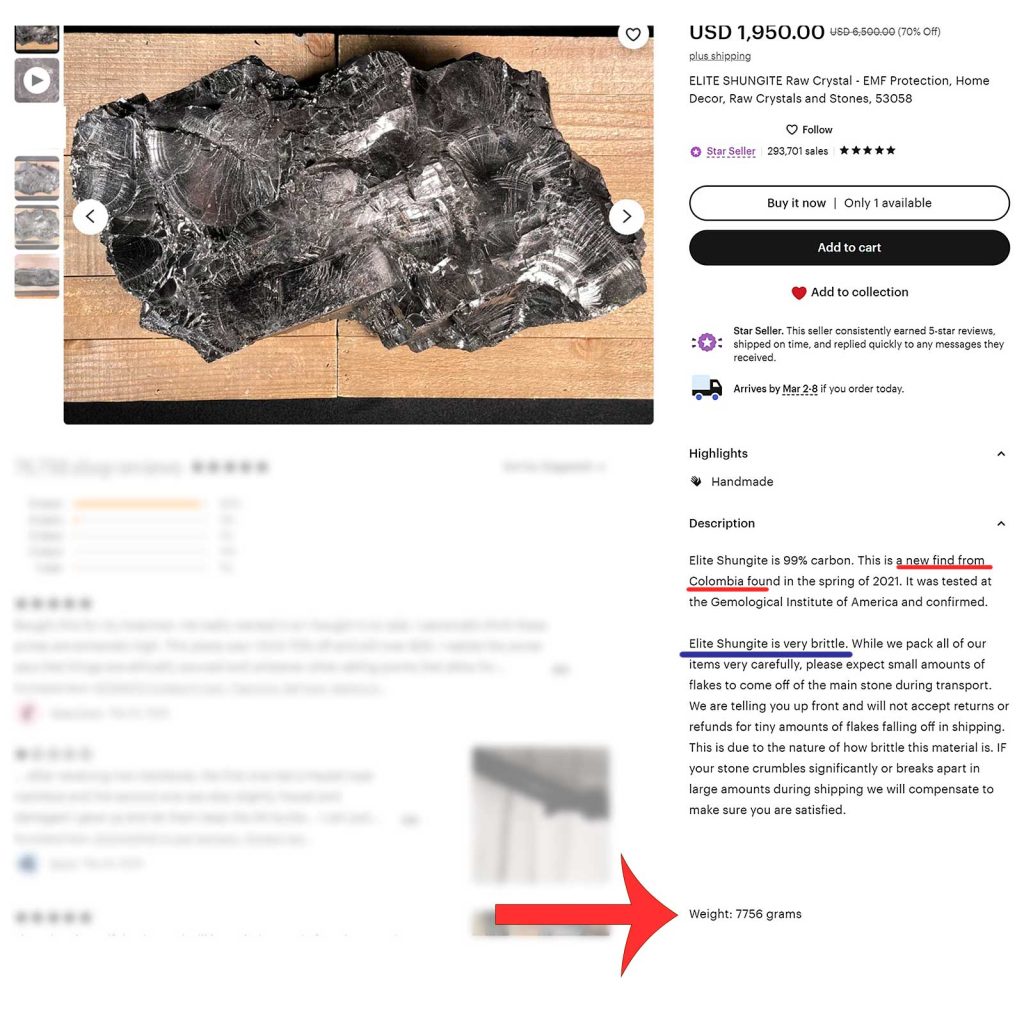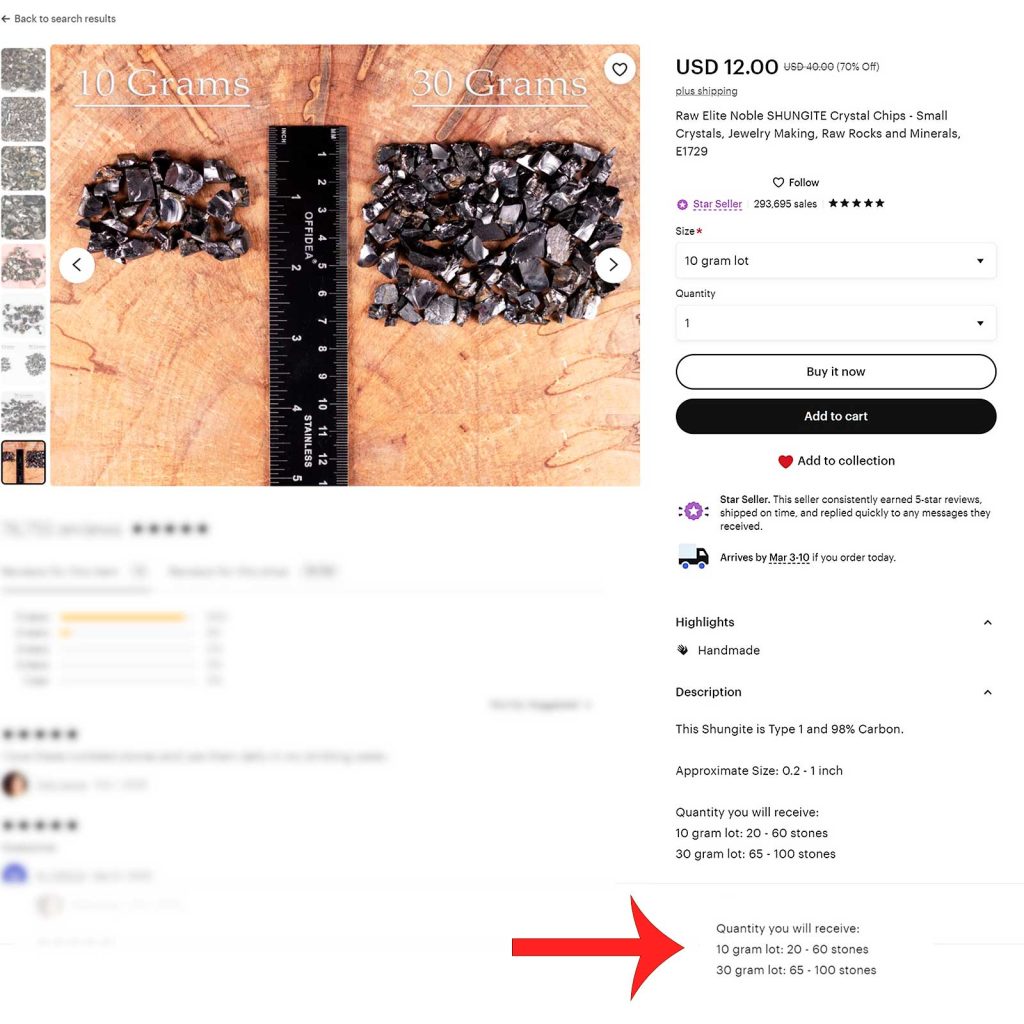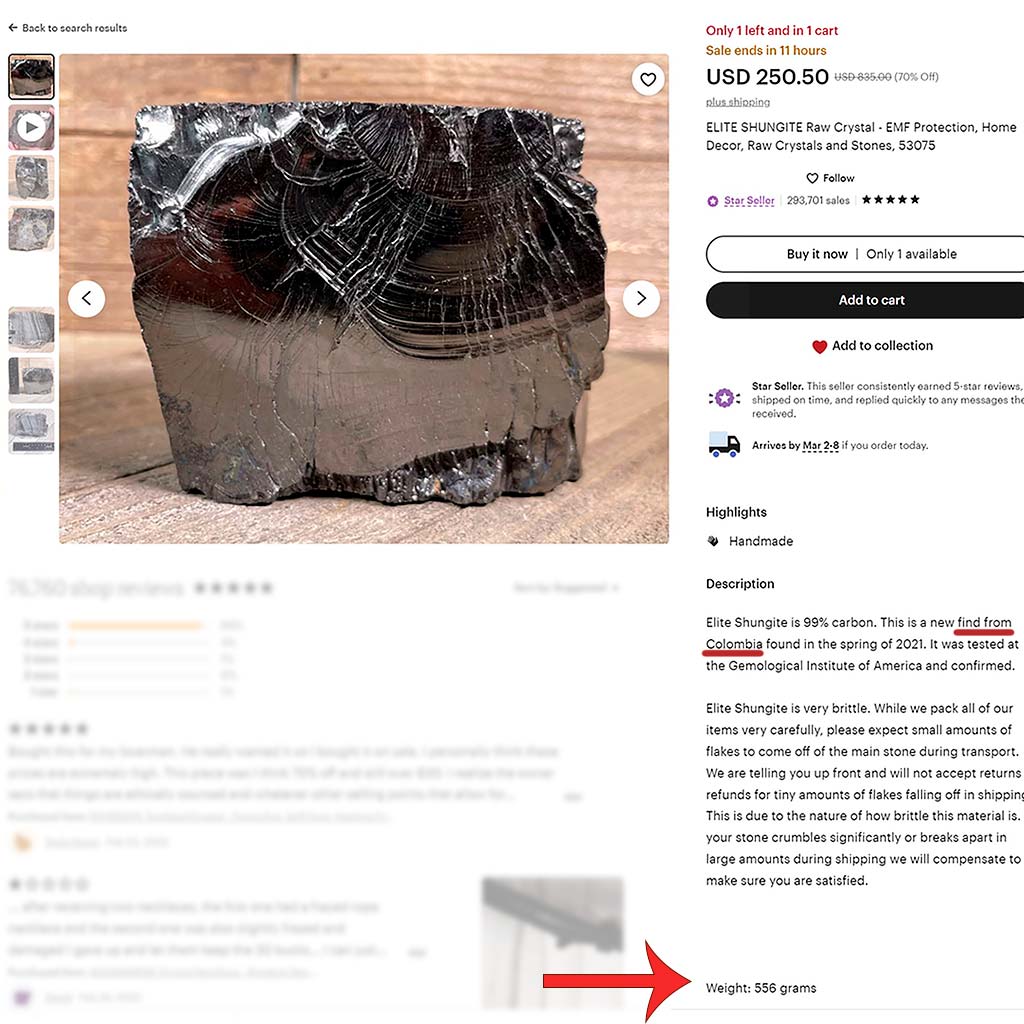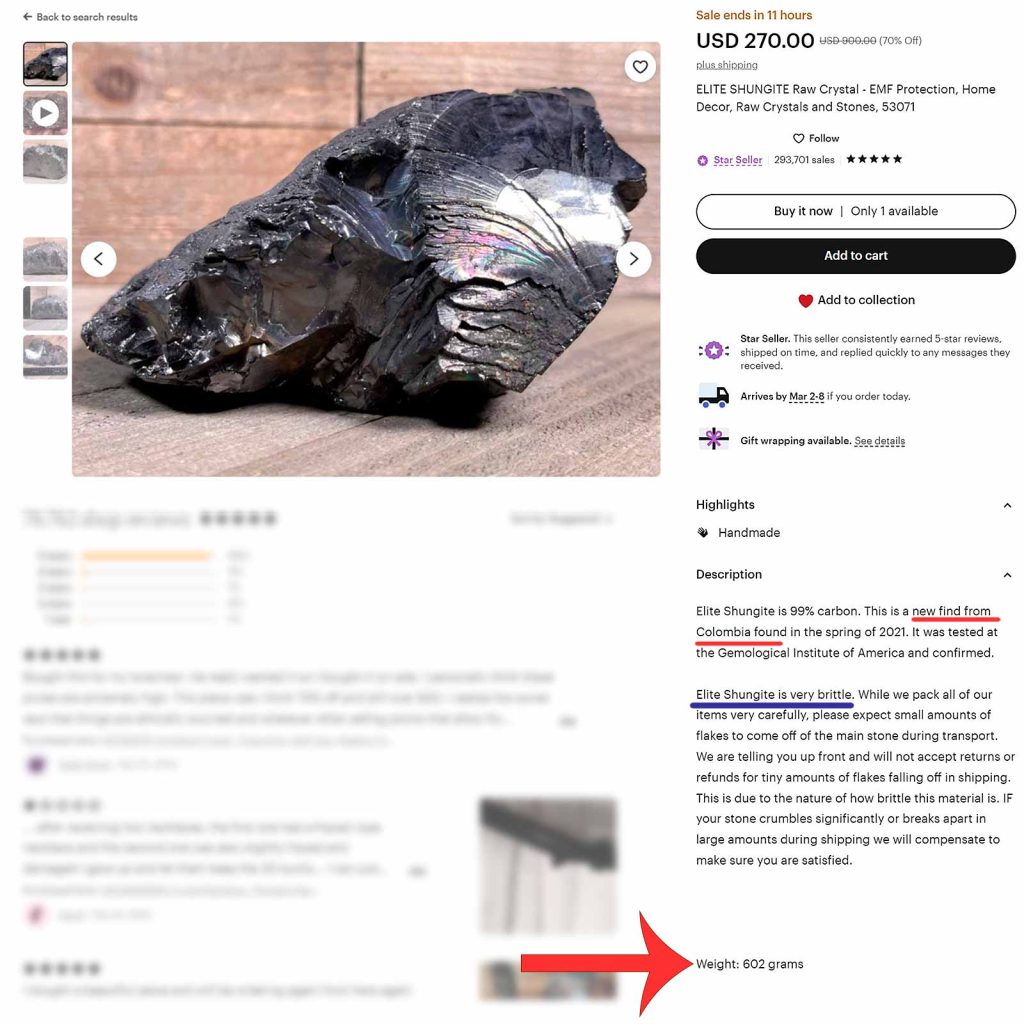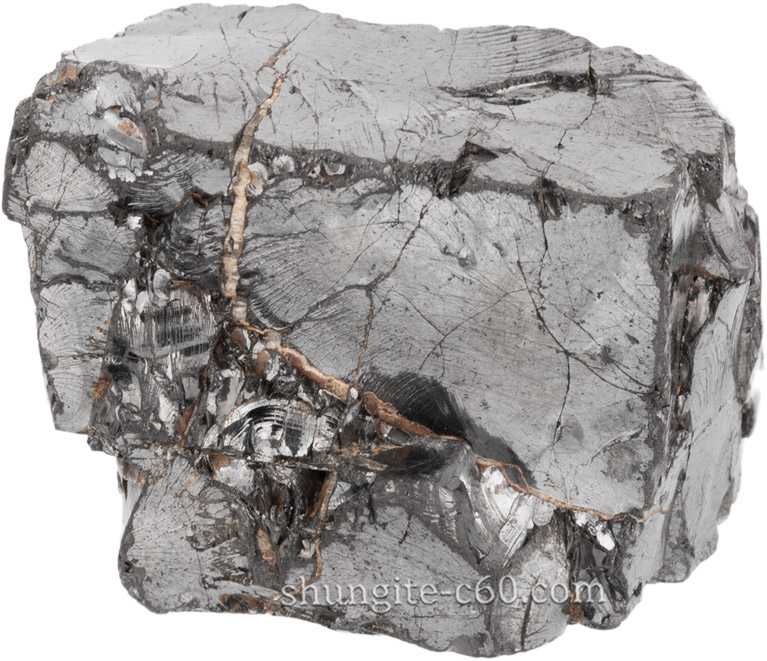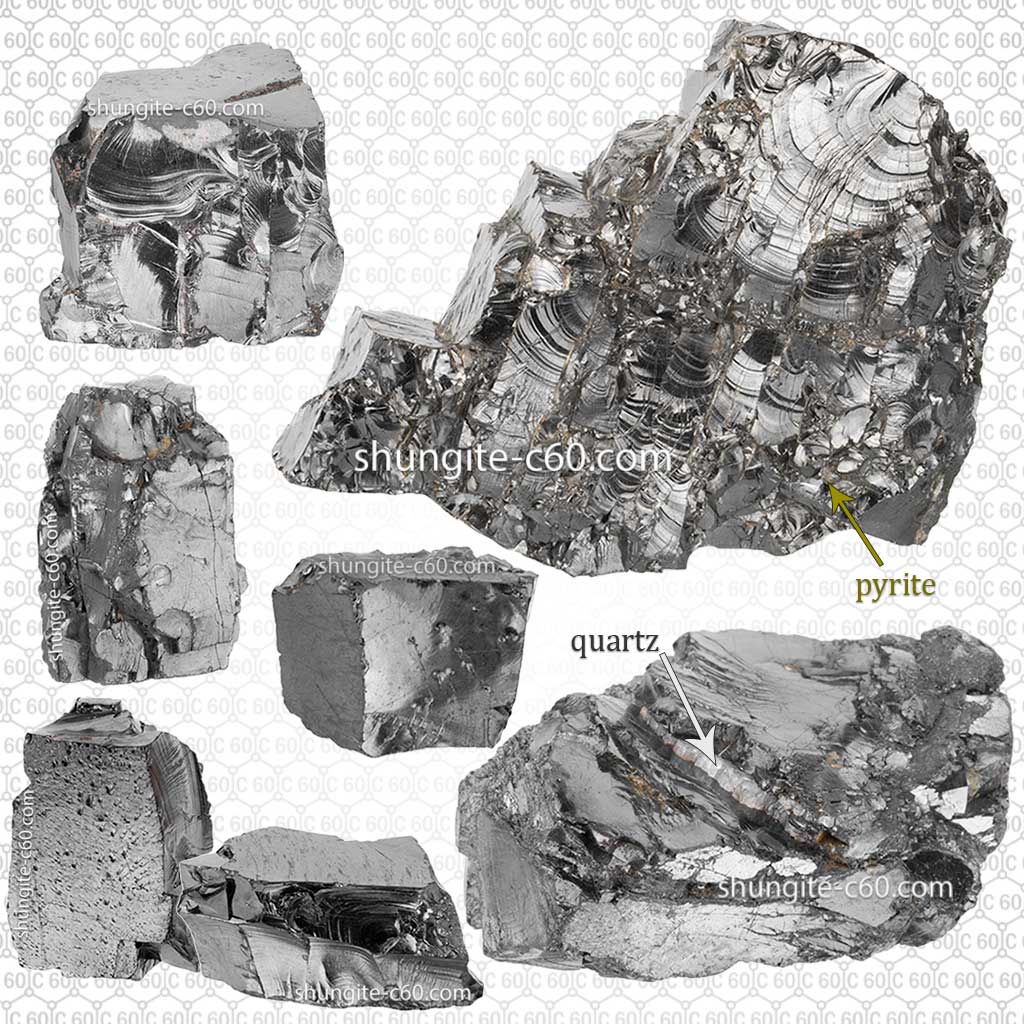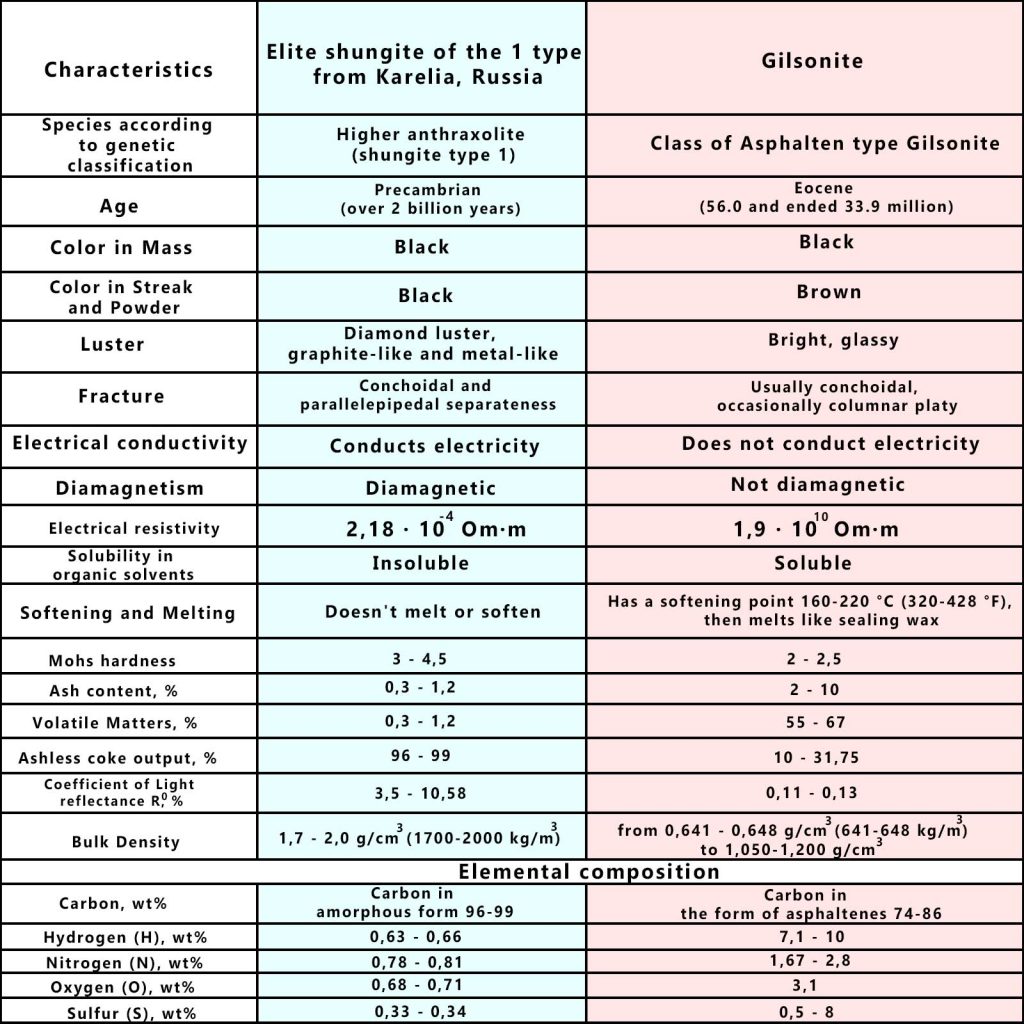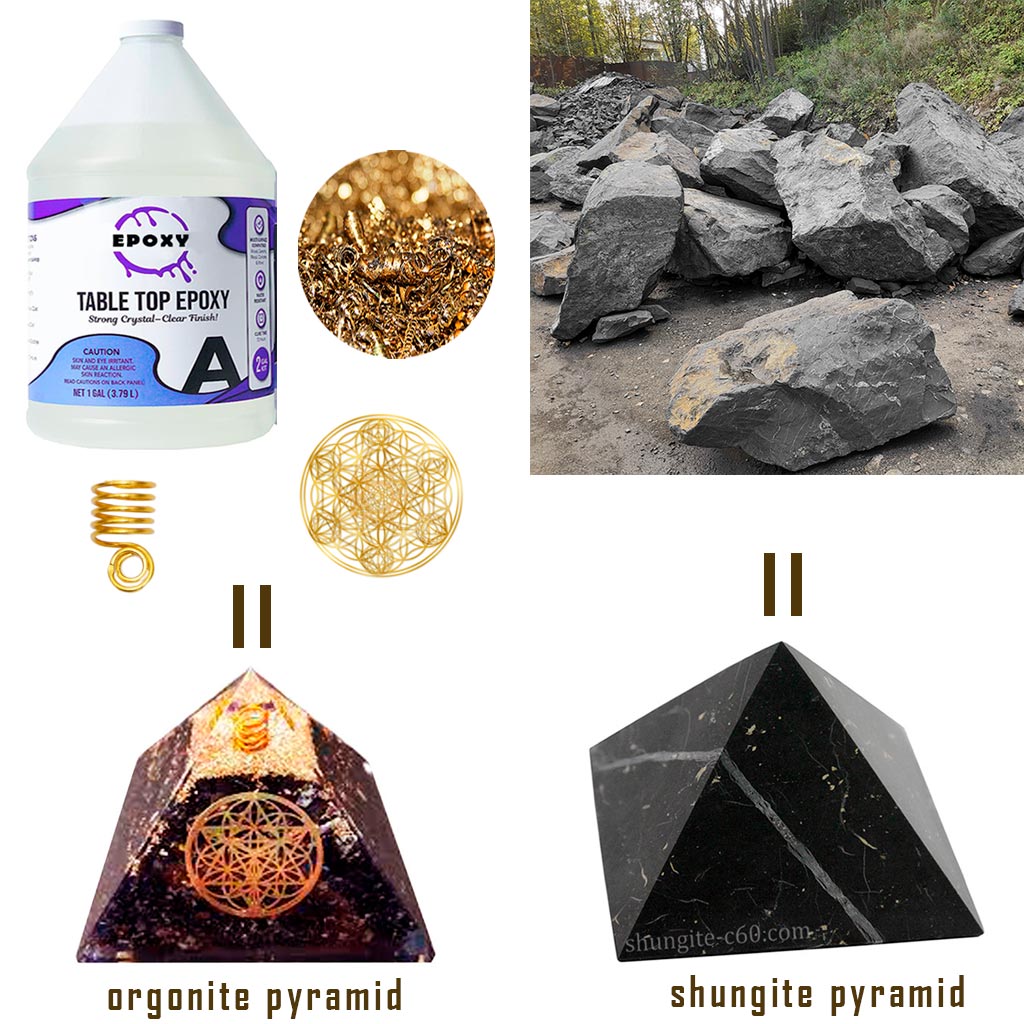In this article we will look at two completely different types of minerals. These are anthraxolite and anthracite. We will identify and find out what each of these types of minerals means and also tell you about the difference between them. We will consider these minerals on two samples. The first sample is the highest anthraxolite from Russia and is called anthraxolite of the first type (elite). The second sample is anthracite coal from Colombia.
Anthracite coal from Colombia
In fact, anthracite coal, also known by the name – Raquirite. This mineral from Colombia has an absolute similarity with a mineral from Russia. But this grey mineral from Colombia cannot be called anthraxolite due to the fact that it is a completely different kind of rock. This grey mineral from Colombia is – anthracite. It is a mineral that has absolutely different chemical composition and physical properties in contrast to the Russian Anthraxolite. These two minerals are united only by a similar appearance of a silvery-grey hue.
Note from the author
The author of this article is Russian, but speaks a little English. The help of an online translator was used to translate the article. The author of the article apologizes to his readers for possible grammatical and lexical errors.
Anthraxolite vs anthracite: Briefly about the main differences
Silver anthraxolite from Russia
Anthraxolite is a silver-colored mineral that reflects light well. The main chemical element carbon makes up about 98% of the total composition. In addition, c60 fullerenes were found only in this mineral. The scientific name of this Russian mineral is the Highest Anthraxolite.
This rock is an excellent conductor of electric current at the level of metals. The resistance of the electric current has a value of 0. Due to the fact that this mineral is one of the rarest in the world, many sellers have an irresistible desire to pass off any similar mineral as a Genuine Russian rare mineral.
Anthracite coal from Colombia
On the contrary, anthracite from Colombia has very poor performance and properties to conduct electric current. These indicators are 1000 times worse than the mineral from Russia. In addition, the scientific name of Colombian Anthracite.
This is a mineral that belongs to the class of ordinary well-known coal. This mineral also contains carbon, but the form of this form of carbon is extremely common in nature. But in Russian Anthraxolite, this form is allotropic and is not found anywhere else in nature.
It is also important to note that anthracite from Colombia is also mined in many countries around the world. But the Highest Anthraxolite is mined only in a tiny region of Russia.
Next in this article we will look at these two minerals in more detail. We will also delve into the specifics of physical properties and chemical analysis to get a more complete picture of the difference between these two types of mineral rocks.
What color is anthracite
Anthracite is a dark, lustrous grey color, often compared to charcoal or deep slate grey. As a coal-like substance, anthracite typically reflects shades of deep, rich grey with a subtle metallic luster, making it a popular choice for various applications, including interior design and fashion.
Its unique he brings a sophisticated and modern touch to any setting, offering a sense of depth and elegance. Whether used in home decor or as a color choice for clothing and accessories, anthracite’s distinct tone adds a timeless and refined element to any palette, making it a versatile and sought-after color option for many design enthusiasts and fashion connoisseurs alike.
What color is anthraxolite
Anthraxolite has the same gray color with a pronounced silver tint. Thus, it is extremely difficult to determine each of the minerals in question only by color. But still Anthraxolite has a higher light reflection coefficient. Therefore, it has a brighter silver color. But in poor light, this one can also have a dark brown color, due to the fact that there is no reflection of light.
Where is the real Russian Anthraxolite rock deposit located?
Our real c60 stone store comes from Karelia, Russia. We are the natives of this land and we know firsthand about the treasures of Karelia, these include the legendary elite anthraxolite stone type 1. This is a very rare mineral, which is more than 2 billion years old, and the age of the planet Earth is about 4.54 billion years. The origin of the Russian silver mineral is still a mystery. And only in this mineral scientists have found unique C60 fullerene molecules.
The only reliably known deposit of Russian Anthraxolite in Karelia is currently practically empty, but hardworking people can find small veins of elite stones. But there are very, very few of them, these are rare finds that are given at a high price. And finding some big nuggets is almost impossible.
Therefore, when we were informed that samples of some supposedly anthracite from Colombia appeared on the network, which, moreover, they were usually gigantic in size, we were very surprised.
For this reason, we conducted a large study in order to understand where this term anthraxolite from Russia or Raquerite came from. And as a result, we realized that, those who write that they found Russian Anthraxolite in Colombia, they are telling lies. After all, there are no anthraxolite deposits in Colombia. In this country , you can find gilsonite and anthracite, which are similar to anthraxolite from Russia only in appearance.
That’s why, here we will talk in detail about how we tried to understand what is hidden under the name elite anthraxolite from Colombia. And most importantly, we will show you how to distinguish Raquirite from Authentic Russian elite stone type 1.
After all, in fact the anthracite coal from Colombia is fiction and falsification, speculation on the glory of the rare mineral anthraxolite from Karelia.
Colombian Anthracite under the guise of the Highest Anthraxolite from Russia
We assume that under the brand name elite anthraxolite from Colombia, many sellers sell something that looks like anthraxolite from Russia, but in fact is anthracite mineral. Maybe it is some kind of solid hydrocarbon, similar to gilsonite, or anthracite coal. We will try to find out what kind of sample it is and consider all options.
We will consider all the properties of gilsonite, anthracite and possibly other supposed minerals and compare them with real Russian Anthraxolite. Let’s start with Gilsonite.
Gilsonite is a natural asphaltene, a solid hydrocarbon, a product of oil oxidation. Gilsonite looks very similar to silver c60 stone from Karelia, Russia. But the similarities end there. It does not conduct electricity and does not have the unique properties that real anthraxolite has. Gilsonite is by no means an elite shungite. They belong to completely different genetic classes.
And calling Gilsonite Anthraxolite is the same as calling pyrite or copper gold. Or call silver platinum. After all, they are all metals and are very similar to each other in appearance. This is where the similarities. And we have done a great overview of their differences for you here in this article.
Where can you find something that looks so much like Russian Anthraxolite in appearance?
Gilsonite deposits amount to billions of tons in different countries, primarily in the USA, Colombia and other countries. Asphalten gilsonite can also be bought by the ton from vendors and is low cost.
However, Gilsonite and Russian Anthraxolite are different concepts. If Gilsonite is a natural asphaltene, then Russian silver stone belongs to another class – higher anthraxolites. And in geology, these concepts are not something similar or the same. Because according to their chemical, physical and molecular characteristics, they belong to different classes.
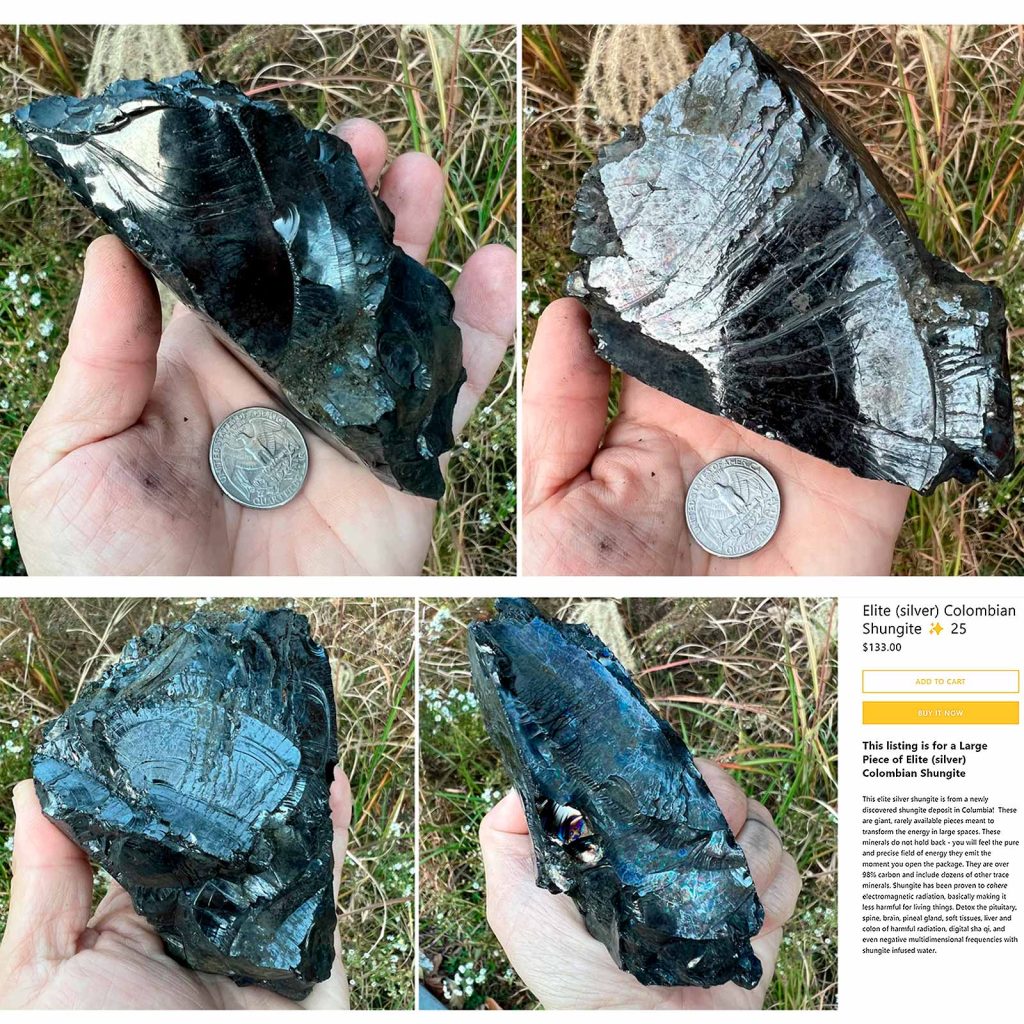
By the way, please note that many samples of the so-called elite anthraxolite from Colombia have a bluish coating. Such plaque is not typical for Russian Anthraxolite. However, such a bluish coating occurs in anthracite from a single deposit in the US, Pennsylvania.
The rock deposit of Colombian anthracite coal
Because Colombia anthracite does not exist, however, there is a natural asphaltene very similar to it – Gilsonite. There are many deposits of natural asphalt around the world: in the USA, Iran, China, and there are also in Colombia.
For example, we found a Gilsonite deposit in Colombia, South America. These photos are from the site of the real Gilsonite seller.
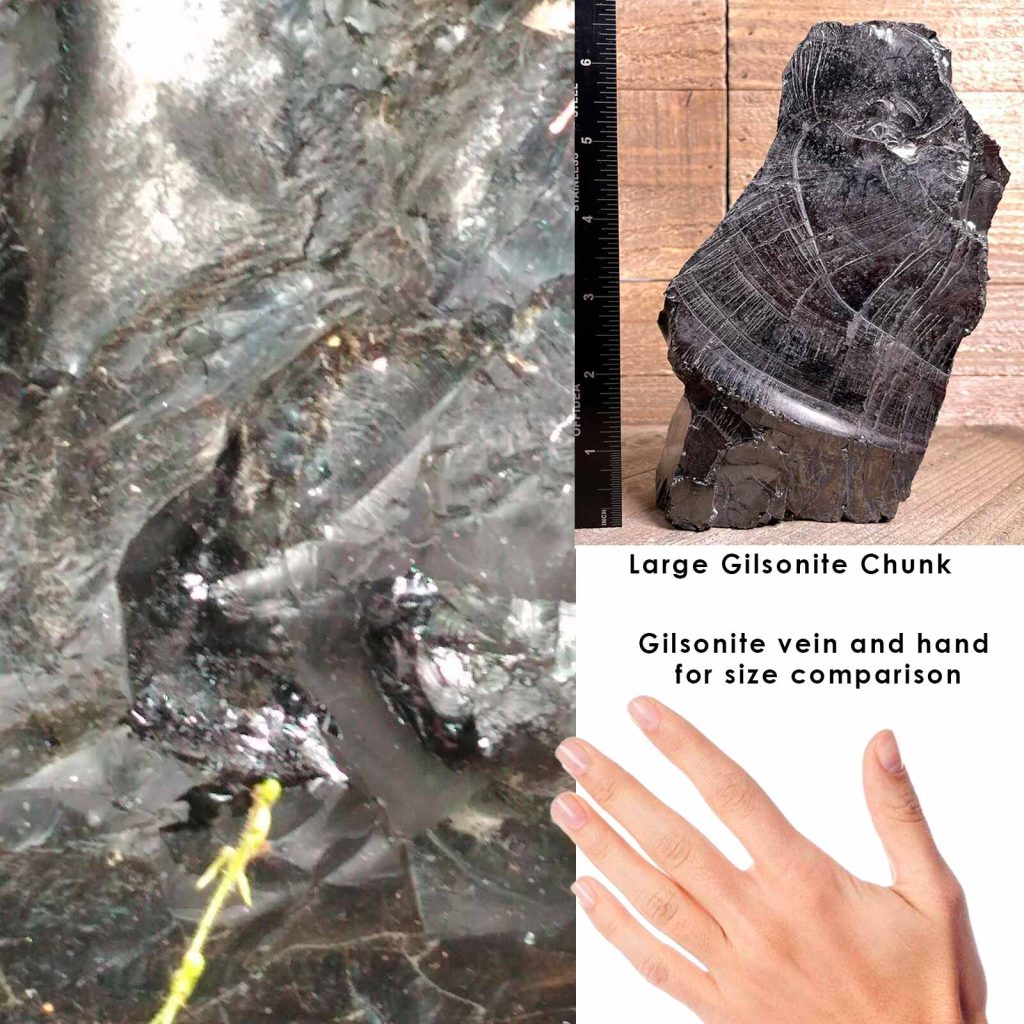
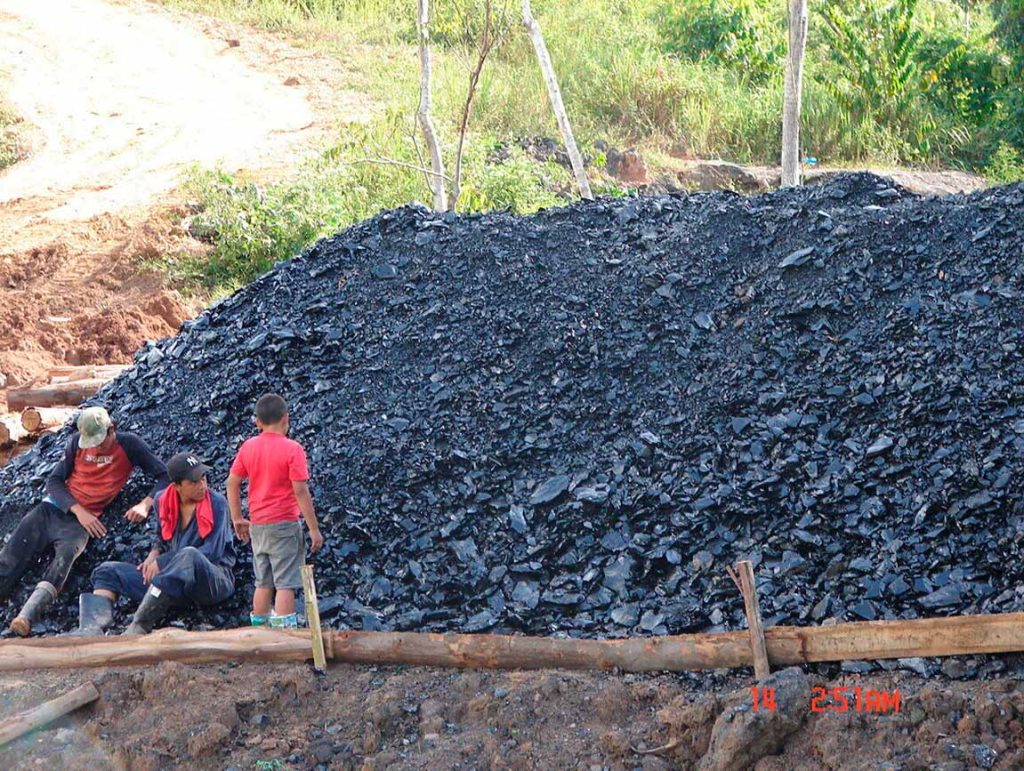
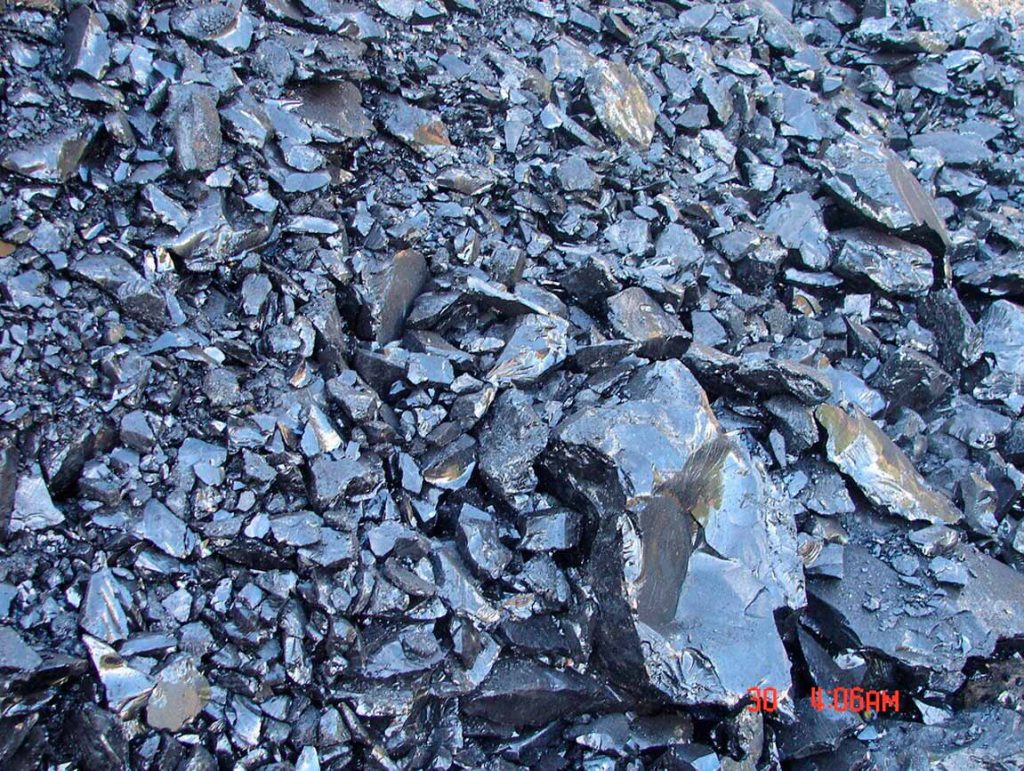
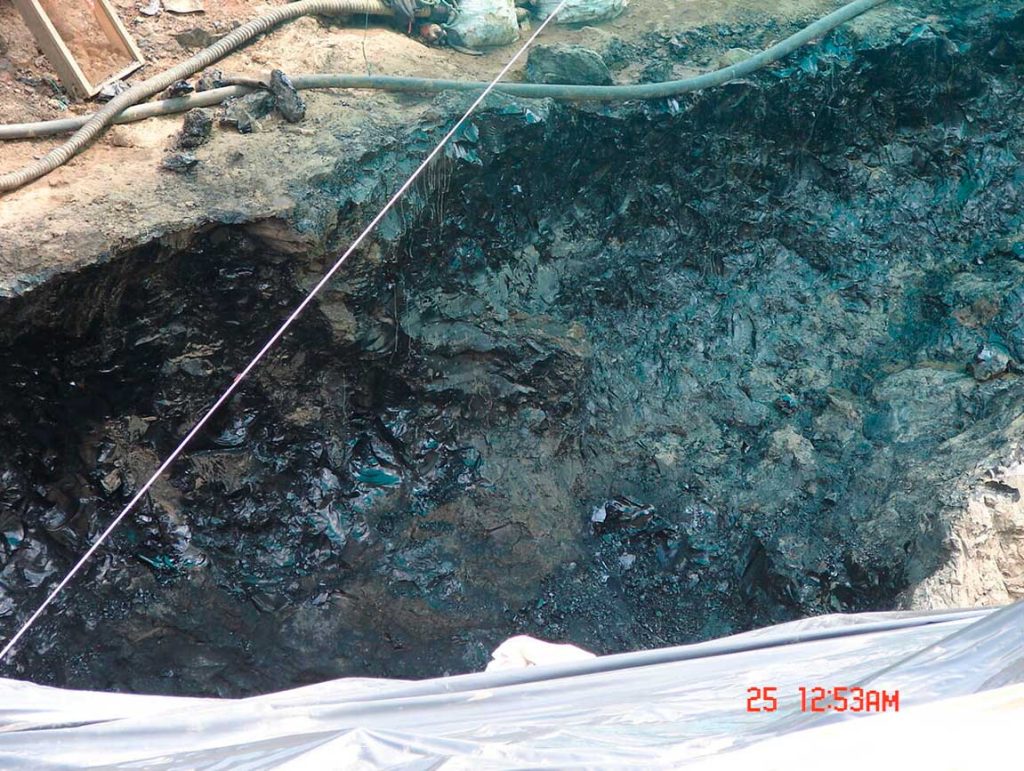
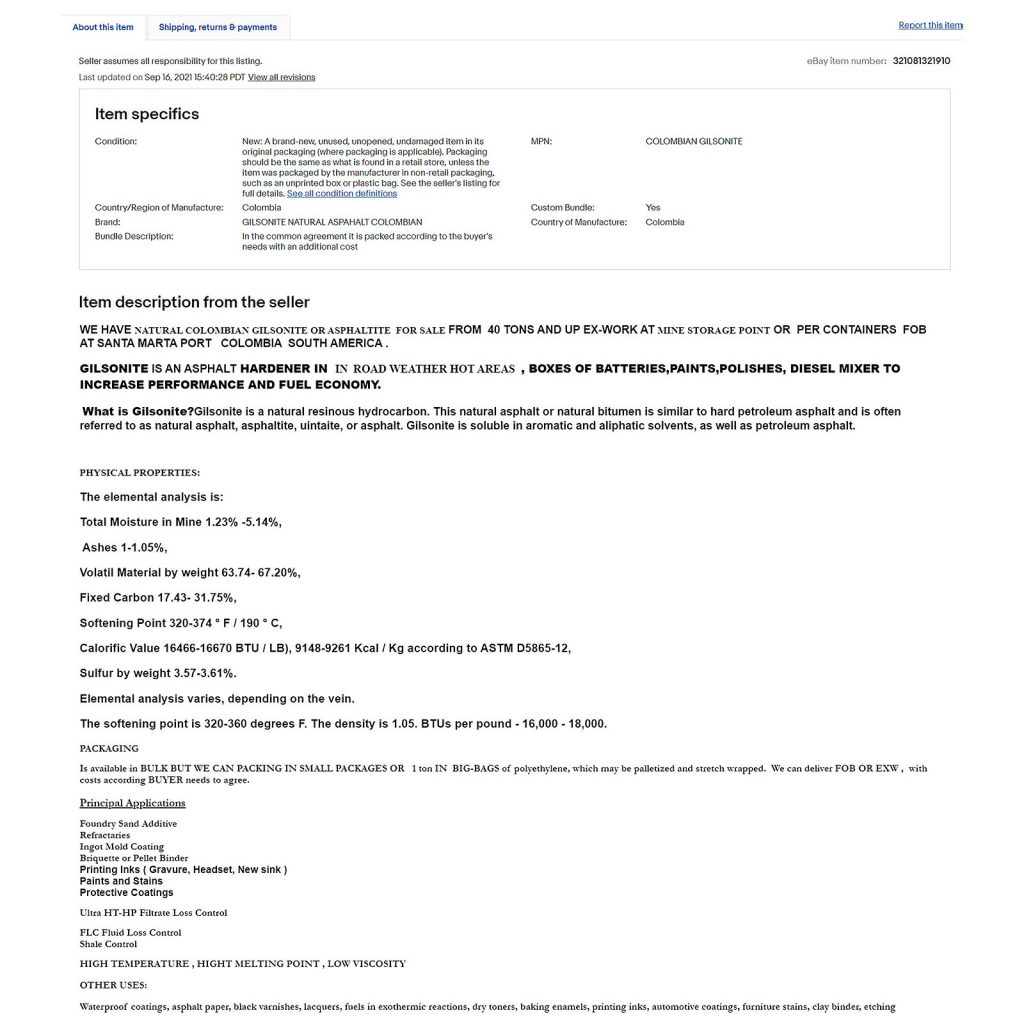
Note that gilsonite looks blue in the photo. It is actually black and quite shiny.
In nature, in sunlight, such objects appear bluer due to the presence of the blue spectrum of sunlight and the peculiarities of human visual perception. Our eyes have more blue cones and are more sensitive to the blue that reflects off surfaces.
How much is Columbia Gilsonite worth?
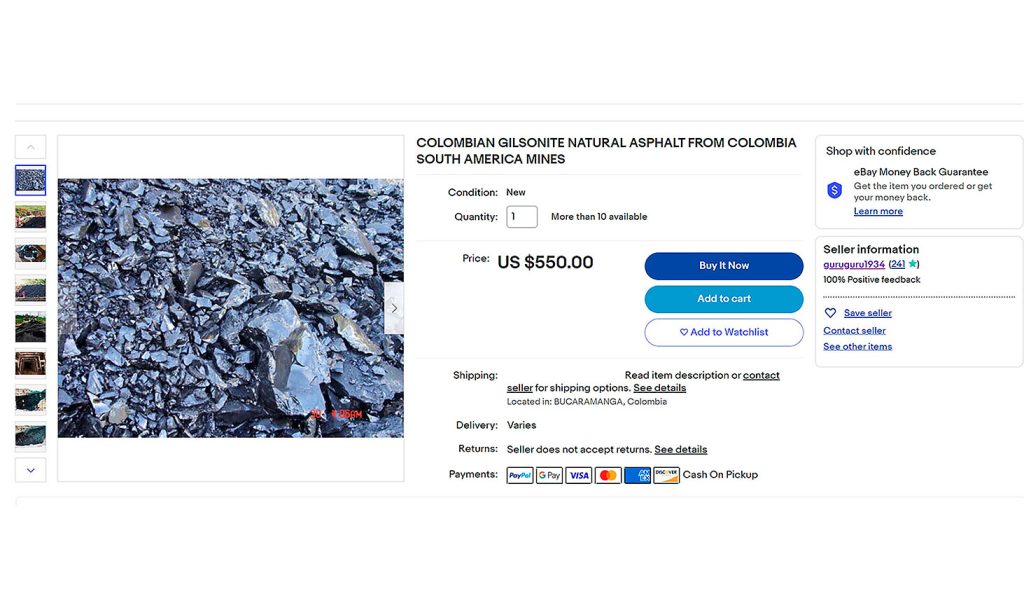
As you can see, you can buy Colombian Gilsonite for $550 per ton, with a purchase of 40 tons. This is 0.55 cents per kg, or 0.00055 per gram.
Deposits of Gilsonite in the USA
Gilsonite is a natural asphaltite, a solid hydrocarbon and its deposits exist all over the world. However, the name Gilsonite itself is a patented name for a type of asphaltene that comes from the USA, Uintah County, Utah.
The deposits of Gilsonite are known in the USA in Uintah County, Utah in Pariette Mine (Culmer Mine) and the Bonanza Mine.
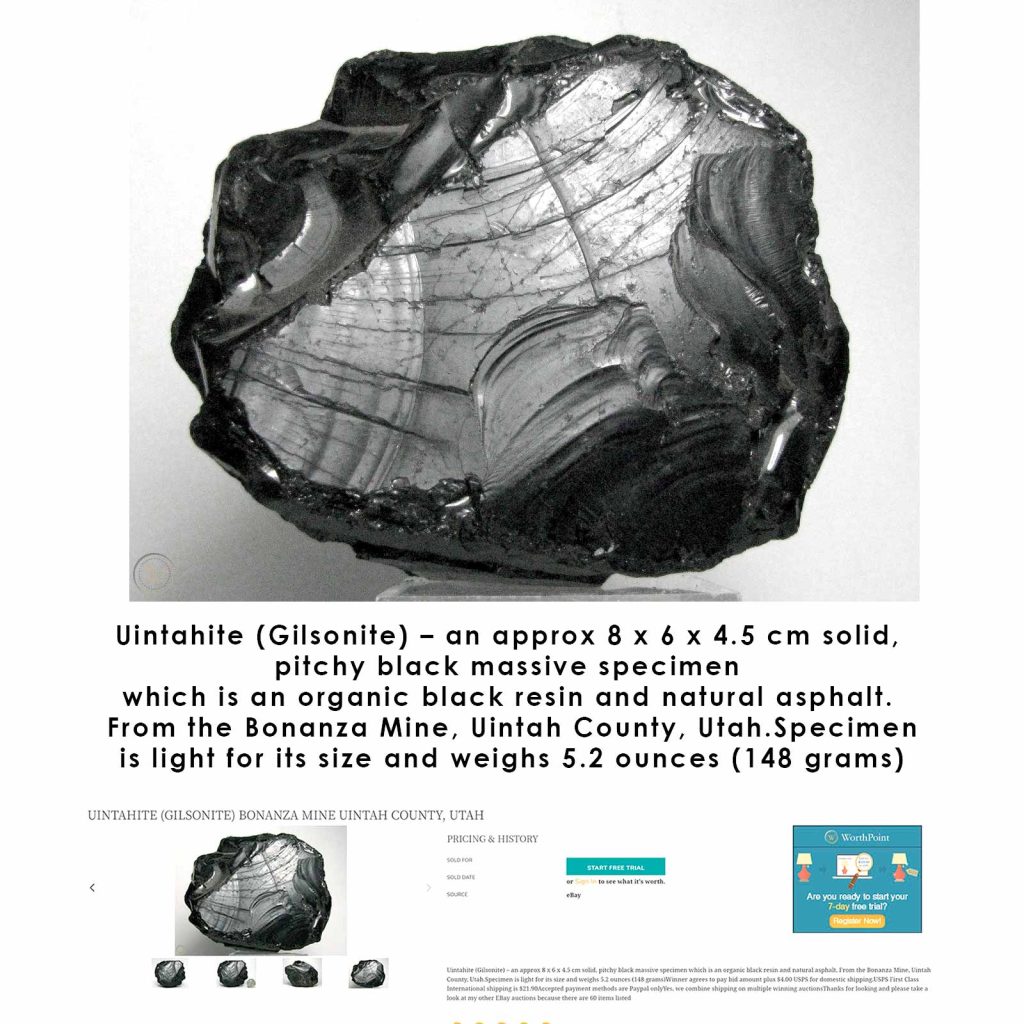
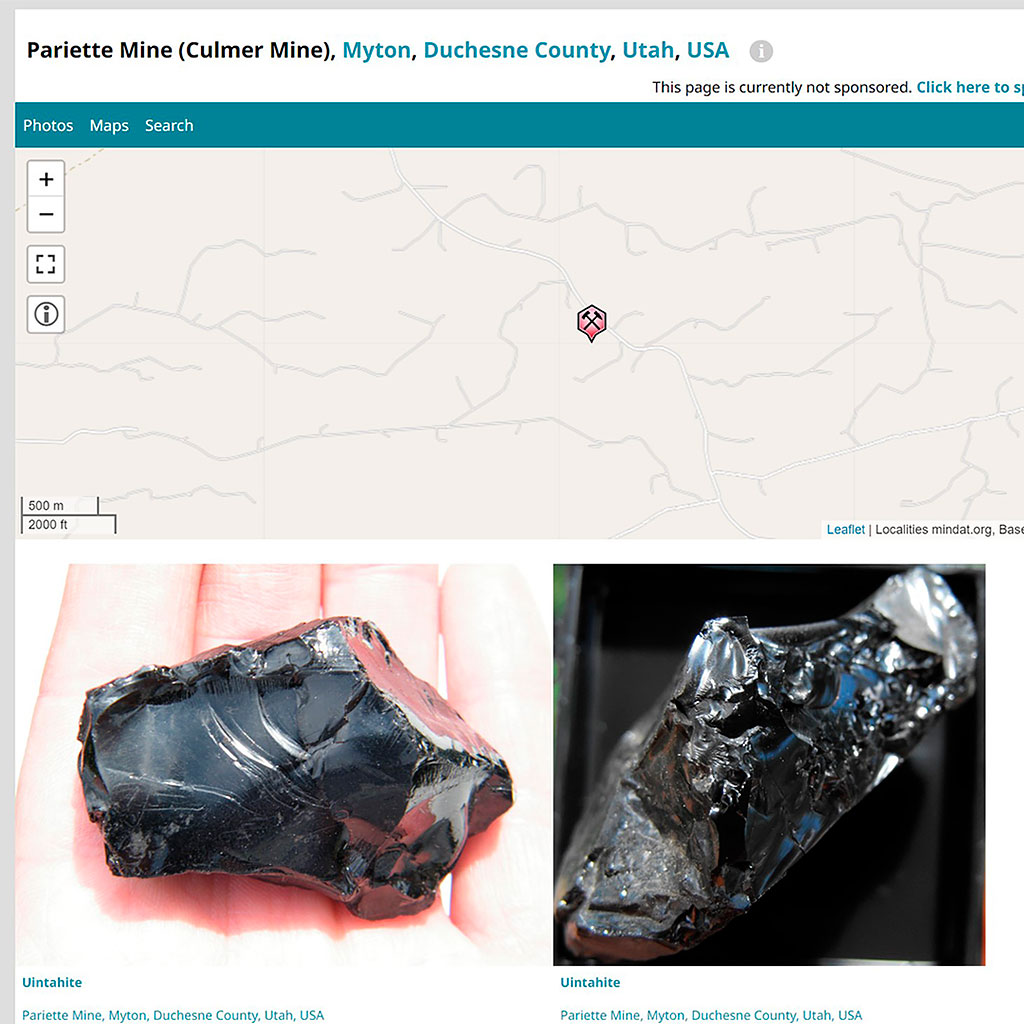
So in Uintah County in Utah, USA in the 1880s, a grade of natural asphalt Gilsonite was patented by the name of the industrialist S. Gilson, who promoted this ore on the market. However, this natural Gilsonite asphalt also has a geographical name Uintahite, Uintah.
Gilsonite in Utah occurs below the Earth at a depth of about 1500 feet or 450 meters in veins or layers that extend for many kilometers. These veins run parallel to each other and are in a narrow minning face. Gilsonite veins are found mainly in the Uinta Formation of Eocene age. The Eocene is the second geological epoch of the Paleogene period. This period began on 56.0 and ended 33.9 million years ago.
Russian Anthraxolite from Karelia, more than 2 billion years old, and gilsonite asphaltite, in fact, are not similar to each other. The mineral Anthraxolite and asphaltite cannot be attributed to the same species, since they have different composition, physical and chemical properties, age and origin. Therefore, geologists gave them different names.
Gilsonite Mining
In addition to the USA and Colombia, a special type of asphaltene – Gilsonite is also mined in other parts of the world. These include Iran, Asia, Argentina, Indonesia, Albania, Azerbaijan, and others.
The production of Gilsonite is estimated at millions of tons per year. How, for example, does Gilsonite mining look like in Asia.
By the way, pay attention, in the second video, the dust from Gilsonite has a brown color. In fact, the color of Gilsonite in powder is dark brown or with a hint of brown.
And vice versa, the color of Authentic Russian stone c60 is black, powder color and color of streak.
Gilsonite: physical and chemical properties
Let’s take a closer look at what Gilsonite is. Gilsonite is a solid mineral hydrocarbon belonging to the asphaltite class. It is a hard brittle substance with a glossy black color and a rather bright sheen. The color of the line is brown. The fracture is conchoidal. Does not conduct electricity.
Gilsonite contains 70-96% asphaltenes with nitrogen compounds. It has a melting point above 130 degrees Celsius. It is soluble in carbon disulfide, carbon tetrachloride and many other non-polar organic solvents.
What is real silver stone type 1 from Russian?
Genuine Russian silver stone has unique properties that made it famous all over the world. Russian Anthraxolite (minneral of the first type) from Karelia, Russia belongs to the genetic class of the highest anthraxolite of the Precambrian period, that is, it is hard bitumen with the highest degree of metamorphism, it conducts electricity and is diamagnetic. Does not dissolve in organic solvents and chloroform, does not decompose, does not melt. When heated, it does not give liquid products, it cracks.
The color is black, the color of the streak is black, the Fracture is conchoidal, it has a metallic or diamond luster and a specific gravity of 1.3-2.1 g/cm3 . Hardness on the Mohs scale from 2-3 to 4.5. Carbon content 96-99%, hydrogen content about 1%. The composition contains heteroelements (N, S, O).
The ability of Gilsonite to soften and melt, as well as to dissolve
The Gilsonite is usually classified as a subgroup of “bituminous materials”. The physical, chemical and other properties of Gilsonite vary greatly from sample to sample. However, Gilsonite can be softened, melted and dissolved in organic solvents.
None of these listed things can be done with a real Russian Anthraxolite of the first type from Karelia, Russia.
Real elite silver stones does not have a softening temperature and it does not melt. Also Anthraxolite of the first type is not soluble in any solvents.
How to melt Gilsonite
The unique grade of natural asphalt Gilsonite from Utah has a low softening point 160-220 °C (320-428 °F ). On the other hand, Colombian Gilsonite has a softening point of about 160-190 °C (320-374 °F ).
As, for example, in this video, this brand of gilsonite is melted down. This specimen comes from Iran, Gilanegarb and Gasreshirin deposits, Kermanshah on the border with Iraq. It has a softening point at 130-210 degrees Celsius (266-410°F).
This type of asphaltene is slightly different in appearance from Colombian and American Gilsonite, this is a normal deviation. However, they have the same essence, they can be melted.
Russian Anthraxolite of the first type from Karelia, Russia does not soften, does not melt and does not dissolve in any solvents.
Moreover, Gilsonite readily dissolves without heating in aromatic solvents and in most chlorinated solvents. Also Gilsonite, being a hydrocarbon, is somewhat soluble in hydrocarbon solvents. It is more soluble in kerosene and naphtha than in crude oil.
Therefore, Gilsonite is used in the paint and varnish industry, in road construction as asphalt concrete mixtures, as well as in the production of graphite. Gilsonite is a constituent of mortars and cements for drilling oil wells. It is also used as an additive in sand molds in the foundry industry.
Gilsonite is very brittle
Gilsonite is very brittle, and it is much more brittle than real Russian Anthraxolite. These qualities are also fundamental in order to consider them completely different.
Gilsonite has a Mohs hardness of 2-2.5. While the hardness of original Anthraxolite from Russia is much higher and ranges from 3 to 4,5 on the Mohs scale.
Color of streak
By the way, due to this property of brittleness, gilsonite is easily ground into powder. In this case, the color of the powder will be with a dark brown tint. Also, if you draw gilsonite on porcelain, for example, you will see the color of the streak being brown. The fact is that the color of the streak is an important determinant of the color of the mineral. Asphalten Gilsonite has brown streaks. On the contrary, the color of streak of Russian Anthraxolite is black.
In this case, the color of gilsonite in the total mass is black (in solid form), but the color of its powder will have a brown tint. A thin strip of gilsonite powder will be brown. Also the color of the Gilsonite band will be dark brown.
The fact is that the brown color of gilsonite in powder and in a streak means its low degree of metamorphism. And Gilsonite is a petroleum oxidation product that is brown and dark brown and almost black. For example, brown color is also inherent in brown anthracite coal, which is also brown in color and contains up to 76% carbon, it has a low second degree of metamorphism, that is, it is located between lignin and anthracite coal.
Electrical conductivity of Russian anthraxolite and EMF protection
Silver Russian Anthraxolite of the first type from Karelia conducts electric current. It is a semiconductor and also a diamagnet. This is due to its special molecular structure, which only authentic Russian stone has. Here it is necessary to say about the amazing property of Russian rock to absorb and reflect electromagnetic waves of high frequency, which are the most harmful for people and animals.
This EMF protective ability of Russian rock is associated with shungite carbon, and Russian silver stone with a free carbon content of up to 99% and Russian black stone of the third type with a carbon content of around 30% have it. All types of anthraxolite conduct electricity.
The conductivity of silver Russian Anthraxolite is 4762 Sim/m. The specific resistance of elite anthraxolite from Russia is 2,18 ∙ 10-4 Om∙m.
That is, the ability to protect against EMF is associated with a special carbon, as well as with the physical and chemical composition of Russian anthraxolite. Stone c60 Carbon has a special structure, in which there are several types of conductivity. For example, type 1 Russian stone has high-quality electrical contacts between structural units, and there is also a current on the surfaces of globules. These conductive structural units include six-membered carbon structures, pentagons and heptagons.
Is Gilsonite electrically conductive?
The Gilsonite is does not conduct electricity and is not a semiconductor. Because asphaltenes do not conduct electricity. Gilsonite does not conduct electricity and has a resistance to electric current of 1,9 ∙ 1010 Om∙m. The fact that this class of natural bitumen contains hydrocarbons in the form of asphaltene up to 86 % does not mean that it protects against EMF. Indeed, in order to have the ability to extinguish electromagnetic waves, it is necessary that the material be a good conductor. In addition, no research has yet been carried out in the field of protection of Gilsonite asphaltite from high frequency electromagnetic waves.
Elemental composition of Colombian anthracite coal
Let’s see what composition of the samples is declared by the sellers of tColombian anthracite. They simply state that their samples contain 99% carbon. They also write that the analysis was allegedly done at the Gemological University of America. Do you think this is true? In fact, in response to a request to send an analysis of their samples, they said that they did not have this chemical analysis.
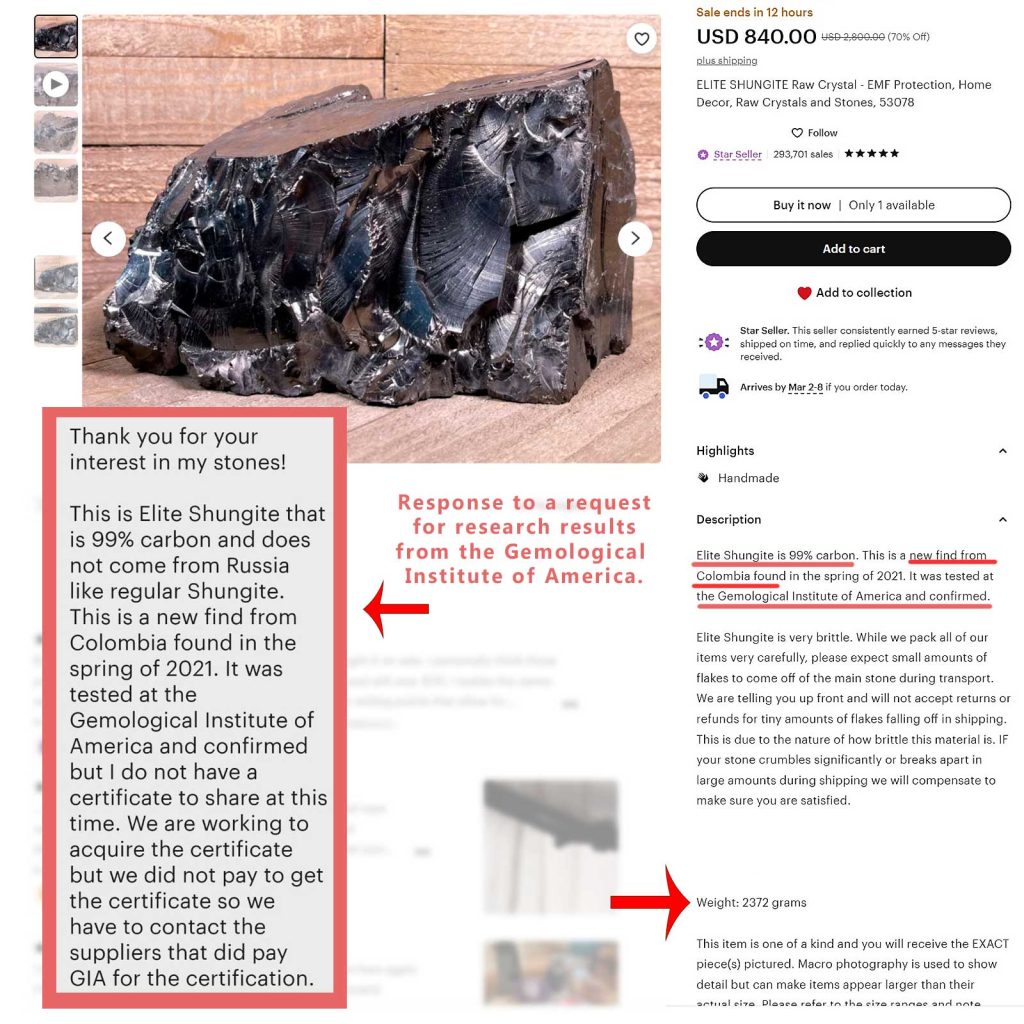
Elemental Analysis of Gilsonite
Elemental composition of asphaltenes (%): C (80-86), H (7-9), O (2-10), S (0.5-9), N (up to 2); there are trace amounts of V and Ni (total content 0.01–0.2%), Fe, Ca, Mg, Cu, and other metals included in metal complex compounds, such as metalloporphyrins. In fact, the elemental composition of Gilsonite, even within the same vein, can differ.
As an example, we will give the composition of asphaltene grade Gilsonite from Utah, USA.
| Elemental Analysis of Gilsonite from the Uintah Basin, USA | Weight, % |
|---|---|
| Carbon, (C) | 84,9 |
| Hydrogen, (H) | 10,0 |
| Nitrogen, (N) | 3,3 |
| Sulfur, (S) | 0,3 |
| Oxygen, (O) | 1,4 |
| Trace elements | 0,1 |
The specificity of carbon in gilsonite is that it is not pure. This carbon is present in the form of asphaltenes (up to 74-86%) with various inclusions. If these asphaltenes are freed from all inclusions, then pure carbon will remain in it. And the percentage of pure carbon in gilsonite is about 10 – 31.75%. This is the amount of carbon that can be obtained after the complete combustion of gilsonite and the removal of all impurities from it, that is, this is the so-called coke number. For comparison, for Russian Anthraxolite it is about 96-99%.
Can Gilsonite be used for water?
We do not recommend adding the gilsonite to the water. Since gilsonite contains hardened heavy fractions of oil in the form of asphaltenes. Gilsonite also contains many volatile substances. It is not known how they will behave in the water.
After all, even when processing asphaltene gilsonites in industrial enterprises, workers adhere to special instructions. This is due to the fact that complex chemicals are formed during the processing of gilsonite. Even gilsonite dust can cause lung disease.
Why Anthracite from Colombia lightweight and real elite Russian c60 stone is heavy?
We again use the false term anthracite from Colombia. Because we want to show with examples how big is the difference between real elite silver Russian stone and supposedly Colombian anthracite.
The fact is that Raquirite will be lightweight. For example, if you take two samples of approximately the same size, then silver anthracite from Colombia will be lighter than real mineral from Russia. It will have a lighter weight due to the lighter structure.
For example, the Gilsonite has a lower bulk density or specific gravity than real anthraxolite from Russia. The bulk density of Gilsonite is from 0,641 – 0,648 g/cm3 to 1,050-1,200 g/cm3, and the bulk density of Russian Anthraxolite is 1,7 – 2,0 g/cm3 .
How to imagine bulk densit?
Imagine a bar of gold and next to it an object that is very similar to a bar of gold (it will have the same shape and color). But this second item will be made of plastic. Which ingot will be lighter? Of course a plastic ingot will be lighter than a gold ingot. Because the structure of plastic and metal is different, plastic is lighter.
Same thing with minerals. This means that the denser the structure of the mineral, the heavier it is. So, for example, Diamond (Bulk Density 3.52 g/cm3 ) has a more densely packed structure with a large number of atoms per unit volume, while in graphite (Bulk Density 2.23 g/cm3 ) carbon atoms are loosely packed. Therefore, two samples of diamond and graphite with the same weight will have a different volume (lighter graphite will be larger in size and, accordingly, in volume).
Calculate the difference between Raquirite and Russian Anthraxolite
As we already wrote, the mineral Russian Anthraxolite of the first type and gilsonite will differ in bulk density.
In the same way, the same difference exists between the so-called Colombian and silver stone from Russia. Therefore, this Colombian anthracite is lighter than Russian authentic silver stone c60. This can be seen even in photographs, especially on the example of large specimens. Samples of so-called anthracite coal from Colombia will always be larger in volume than samples of real Russian Anthraxolite of the same mass.
We will not be able to accurately calculate the bulk density using the volume that we calculate from the dimensions of this anthracite coal from Colombia sample provided by its seller. Therefore, we make calculations very roughly, just to show the difference in volume between samples of genuine and anthracite from Columbia.
Photo of Colombian anthracite and the dimensions of this sample
So, we offer to look at a sample of fictional anthracite coal from Colombia. In the meantime, please note that, it is much duller than c60 Russian Anthraxolite. It reflects light so poorly even in this situation, when it is under the rays of daylight sunlight. This is very important, because it tells us that this sample is some kind of simple bitumen with a low degree of metamorphism. It does not reflect sunlight well and looks black, not silvery, as a real elite anthraxolite should look like.
However, we now want to show the difference in density between Russian Anthraxolite and fictional elite anthracite from Colombia.
How a genuine sample of elite Russian anthraxolite of the first type from Karelia looks like is shown below in the photo. This sample of Russian Anthraxolite was shot in a professional photo studio with studio lighting. This means that the entire sample is uniformly illuminated by light. At the same time, the original Silver Russian stone type 1 reflects light so well that it looks like silver. Although in fact it is black.
We have selected very similar samples, almost the same weight of 228 grams for Russian Anthraxolite stone and 211 grams for Colombian anthracite coal.
We will calculate approximately the volume of these two samples.
Russian Anthraxolite sample has dimensions and volume 6x6x4,2 cm = 151,2 cm3.
A sample of the anthracite coal from Colombia has dimensions and a corresponding volume of 8,7 x 7,2 x 3,7 cm = 231,8 cm3.
The difference in bulk density and volume between anthracite from Colombia and original Russian Silver Anthraxolite
Thus, we calculated a significant difference in there is a difference in volume between Russian Anthraxolite and Raquirite. Because the structure of real elite anthraxolite is denser and its Bulk Density is higher. Approximate volume for Russian anthraxolite was – 151,2 cm3 (weight – 228 gr), and approximate volume for Colombian anthracite was – 231,8 cm3 (weight -211 gr).
In other words, the same thing, if you take two samples of approximately the same size, then a sample of the Anthracite from Colombia will always have less weight than a Russian silver stone type 1. Because of this counterfeit Raquirite is lighter than real anthraxolite in terms of Bulk Density.
These calculations are very approximate and rough, but it is enough to see that these two samples of the almost same weight differ greatly in volume. That is, a sample of anthracite from Colombia is larger than a sample of Russian Anthraxolite by about 53 %.
At the same time, regardless of what is hidden under the brand of anthracite coal from Colombia – Gilsonite, anthracite or any other solid hydrocarbon. There is an objective fact that the bulk density or specific volume (the same terms) of anthracite from Colombia (Raquirite) is much less than that of Russian Anthraxolite for abuot 50%.
This one speaks of the fact that there is nothing in common between the fictional Colombian anthracite and the genuine Russian Anthraxolite. Therefore, whatever is sold under this Colombian name, it has no right to be called anthraxolite.
How to distinguish a Popular Anthracite – Raquirite by photo and description
So, if you see that the mineral is called anthraxolite 99% from Colombia (elite shungite raw crystal) and it is cheap, then this is not Russian Silver anthraxolite c60 stone type 1. This is a common mineral – anthracite, which is a very common mineral that is mined and sold at a low price in different countries.
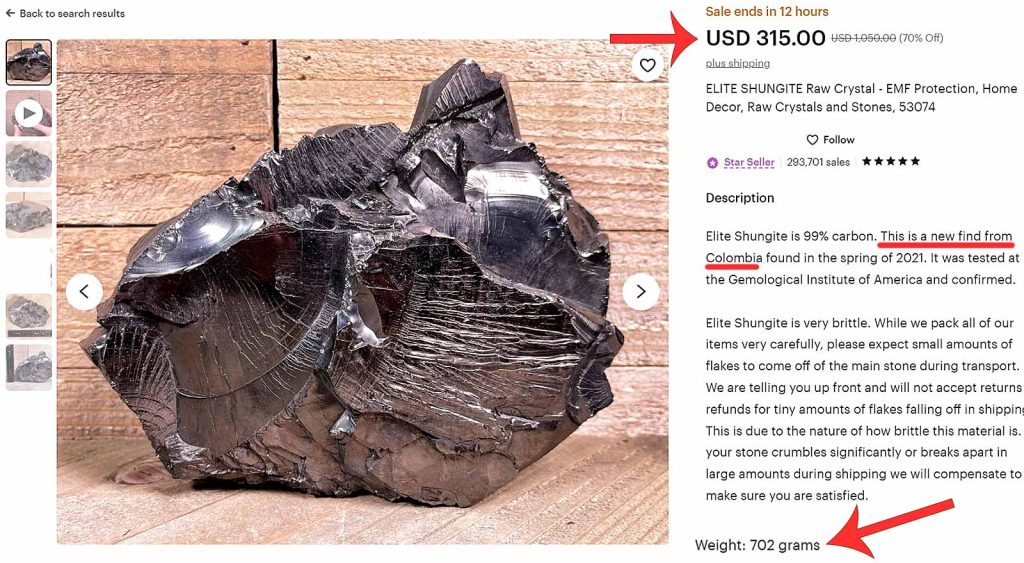
At the same time, there are no deposits of anthraxolite in Colombia, as there is no scientific evidence for this fact. However, in Colombia there are deposits of Gilsonite, which has only some external similarity with the Russian Anthraxolite from Karelia. But Gilsonite is only natural asphalt, which is mined in tons, it has nothing to do with the real elite anthraxolite of the first type. And in geological terms, these are different concepts. A deposit of real anthraxolite of the first type exists only in Karelia, Russia.
Allegedly huge Nuggets are many times cheaper than small pieces
What do you think will cost more, large pieces or small pieces of the same stone? Of course, large nuggets of the same breed will cost much more than small ones. But what if, in fact, these rocks are different and small pieces are a real mineral, and large ones are just pieces of some indefinite solid hydrocarbon? Then you will see the situation as in this case.
Let’s take a look at this showcase, here we will see samples of supposedly Elite Russian stone, which is indicated in the description as Colombian anthracite coal. At the same time, these sellers mislead buyers by indicating the name of their product as Elite shungite raw crystal – anthraxolite. But the fact that this is supposedly fictional anthraxolite comes from Colombia, they modestly indicate only in the description.
This showcase is interesting because in its section it sells only some indefinite solid hydrocarbon in the form of large pieces from 540 grams to 7756 grams under the guise of Russian stone.
But they have only one lot with Russian Anthraxolite of a small fraction (stones 1-3 grams, 12$/10 grams or 1,2$/1 grams ). On this showcase it is shown first on the left at the top.
At the same time, they sell allegedly Russian Anthraxolite in the form of huge pieces, for example, a piece weighing 7756 grams has a price 4.7 times less than small pieces weighing 1-3 grams. Its price was $1,950 per piece, which works out to $0.251 per grams.
One’s own among strangers, a stranger among one’s own.
However, they still resell Russian Anthraxolite of the first type from Karelia. But they only have very small pieces weighing around 1-3 grams at a cost of $1.2 per gram. They also indicate in the description that it is type 1 anthraxolite from Russia. And they don’t lie, because this is a Russian stone and it is expensive. After all, in fact, the Russian anthraxolite mine in Karelia has already been exhausted and small pieces of anthraxolite veins inside it are worth their weight in gold. Look here for real Anthraxolite from Russia of fine fraction without intermediary overpayments.
But at the same time, we see huge pieces of anthracite coal from Colombia at a very low price of 0,251-0,516 dollars per gram, and microscopic pieces of Russian Anthraxolite are sold at 1,2 dollars per gram. Small fragments are 2-5 times more expensive than huge pieces! Agree, this is very strange. At least they gave themselves away at the cost.
Well, this does not happen in life, it is impossible to appreciate the fragments of the breed more expensive in price than the huge nuggets of the same breed. It cannot be said that, for example, this Diamond from Yakutia of 2 carats will cost more than the Diamond from Africa of 3106.75 carats. However, if we suddenly see this particular situation in life, then this means that we are talking about anthracite of grey color.
Why is Russian Anthraxolite silvery?
So, we realized that under the name Russian Elite Shungite – anthraxolite, an ordinary very common rock is sold all over the world – the mineral anthracite coal. This is not authentic Russian rock c60. In addition, I would like to draw the reader’s attention to the color and brilliance of the samples in order to distinguish a Raquirite from a photograph.
In fact, Russian Anthraxolite of the first type from Karelia has a black color. But due to the fact that Russian stone has a high reflectivity, so it looks like silver in the rays of light. The reflection coefficient for silver Russian stone is 3.5-10,58 %. That is, elite stone c60 reflects up to about 10,58 % of solar light for the most brilliant specimens. Of course, it is far from real silver, which has a reflectance of 95%. However, among all minerals with carbon content, only Russian Anthraxolite has the highest reflectivity.
Why do gilsonite and anthracite appear blacker?
But, for example, natural asphaltene Gilsonite has a low reflectivity. In the total solid mass, it is black (but it is brown in powder and streak). But it doesn’t reflect light that much, so when lit it doesn’t look like silver, it looks like black with a glassy sheen. The reflection coefficient for Gilsonite is 0.11 – 0.13%.
Similarly, samples of anthracite do not reflect light well. In general, we cannot state that the reflectivity of Gilsonite and this supposedly Raquirite sample is the same. But the fact is that the anthracite reflects light much weaker than real Russian Anthraxolite.
Look at the photo of pieces of the grey color allegedly Russian Anthraxolite. All of them have a black color and some luster like glass, which is actually much weaker than that of the Russian stone. Therefore, anthracite does not look silver in the light.
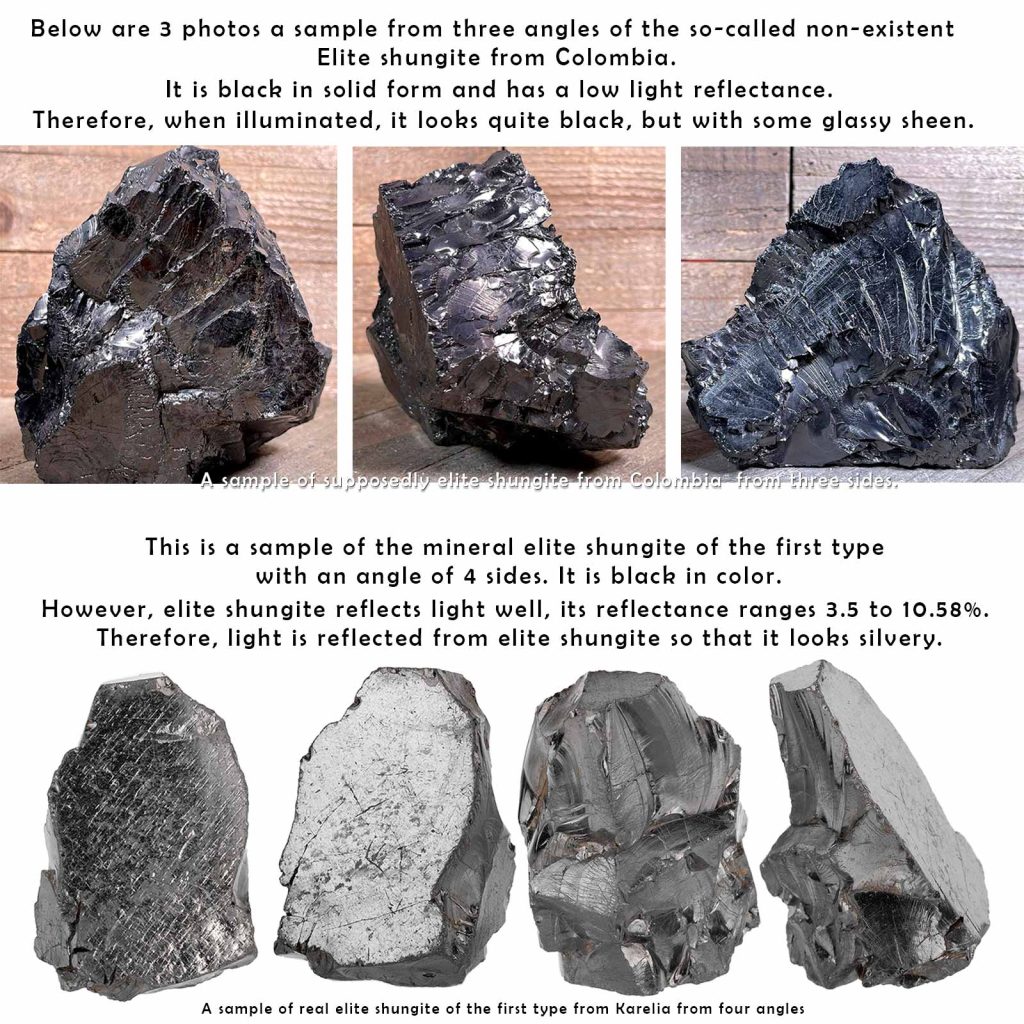
Why is shine so important?
The fact is that the property of a mineral to shine (reflectivity) is very important in order to determine whether a mineral belongs to a particular species. That is, each mineral has its own brilliance and its own reflectivity index. The higher the reflectivity index, the more light the mineral reflects, the brighter it shines.
That is why real Russian Anthraxolite, which has a black color, but in the light looks like silver. And such a strong shine of the Russian rare mineral is described as metallic and diamond.
But this so-called Raquirite has some glassy luster, so its in the light does not look like silver, it will be almost black.
What to do if it is not clear how shiny the sample is?
Ultimately, determining the luster of a mineral can be a difficult job for those with little experience. Still, the degree of gloss and the reflection index of the mineral is determined on special equipment. And we can only be guided only by our subjective opinion, which may differ from objective reality.
But do not despair, if there are doubts about the brilliance, then do other experiments with your samples. For example, check for electrical conductivity, because only real Russian Anthraxolite conducts electricity, but Gilsonite does not.
And also run this piece over white porcelain to make a streak and see its color. Finally, you can pulverize your sample a little. And if the color of the streak or the color of the powder is brown or with a brown tint, then this means that you have a stone – Gilsonite. After all, a real Russian Anthraxolite will have a black color streak and powder.
By the way, an interesting fact. After all, the degree of metamorphism (the degree of change in carbon) affects the brilliance of the mineral. And the higher the metamorphism of the mineral, the stronger the brilliance it has. And Russian Anthraxolite has the highest degree of metamorphism. No mineral with a carbon content has such a high degree of metamorphism.
And the degree of metamorphism depends, among other things, on the age of the mineral, for example, Russian silver stone has a very ancient Precambrian age (more than 2 billion years). But gilsonite – there is a very young variety of Asphalten, whose age will be the maximum of the Eocene period (30-50 million years). Therefore, Gilsonite reflects light rather little and weakly shines, because its reflection index is 30-90 times less than that of real Russian Anthraxolite.
Quartz and pyrite are found in cracks only in Russian Anthraxolite
An important confirmation of the authenticity of Russian Anthraxolite is the presence of veinlets of quartz and pyrite minerals in it. This is due to the antiquity of the stone. After all, the silver stone from Russia was formed in Karelia more than 2 billion years ago. And after this time, cracks formed in the stone, into which the mineral quartz and pyrite fell.
Unlike genuine Russian Anthraxolite, natural asphaltene Gilsonite does not have such inclusions, since this asphaltene is very young and it is just solidified and oxidized oil. It is known that the oldest age recorded for American Gilsonite is about 30-50 million years.
In the same way, we do not see any traces of quartz in the photographs of this supposedly Russian Anthraxolite from Colombia.
How to distinguish anthraxolite from anthracite
- Ask if a sample of anthracite coal withstands the test for conductivity. Usually you will be told that they do not know if the sample is conductive or not. This is due to the fact that in fact their sample does not conduct electricity, since it is not a real Russian Anthraxolite.
- Samples of imitation anthraxolite have a duller sheen, as they reflect sunlight less and look blacker. And vice versa, samples of the Russian stone look silvery if the light is directed at them.
- Samples of Colombian anthracite often have a bluish coating, which is associated with films of vanadium oxides on their surface. Also often these samples have iridescent hues on the surface, which is also associated with films of metal oxides.
- Anthracite it is very brittle, it more fragile than real Russian Anthraxolite. This is also indicated by the sellers of fake anthraxolite themselves.
- Colombian anthracite coal does not have quartz and pyrite inclusions in cracks.
- Sellers note that their supposedly anthracite is from Colombia. In fact, under this fictitious name, there is some unidentified solid hydrocarbon from Colombia, or from the USA, or from anywhere else in the world.
- The fictitious name Raquerite means the same thing, under its guise they sell the same unidentified solid hydrocarbon.
- Very low price and very large size of the lumps. As a rule, the price of anthracite is about half the weight of the sample. And for large pieces – about a third. For example, a price of $200 usually goes for a weight of 400 grams or a little more.
Sample Specific Gravity or Density.
We use the term “bulk density”, which is the same term as “specific gravity”.
- If you take two samples of the same weight, then anthracite sample will be 50 percent or more larger in volume than the Russian Anthraxolite. This also means that samples of the anthracite are anthraxolite. That is, in fact, it is some still unknown solid hydrocarbons.
- In other words, the same thing, if you take two samples of approximately the same size, then a sample of Colombian anthracite coal will always have about 2 times less weight than Russian Anthraxolite. Because based on the sample sizes provided by these sellers is lighter than real anthraxolite from Russia in terms of specific gravity.
How to understand that your anthraxolite is a imitation on physical experience
Conduct an experiment on the conductivity of electricity of your sample using a multimeter or a small light bulb. Only real Russian Anthraxolite has the ability to conduct electricity. Real c60 silver Russian anthraxolite should have such a value of current resistance that tends to zero. If the sample does not conduct electricity, then it means that it is not a Russian Anthraxolite. Conductivity testing is enough to determine the authenticity of the sample.
Russian anthraxolite vs Gilsonite
In order to distinguish between different bitumens, there are many classifications, but the main parameters are given in the table. From this table, you can see the differences between Russian silver Anthraxolite and the Gilsonite.
After all, the ard natural bitumen of the asphaltene class Gilsonite and the Precambrian higher atraxolite, known as Russian stone of the first type, are at opposite ends of the genetic classification.
So maybe the Raquirite is Gilsonite?
So, we tried to understand whether Gilsonite is hidden under the name of Raquirite. We examined the real qualities of Gilsonite and showed you that Gilsonite is very different from Russian Anthraxolite. We found that many qualities of Gilsonite are similar to those we see in anthracite from Colombia. However, we cannot say with certainty that Gilsonite is anthracite.
However, we can definitely say that samples of anthracite from Colombia are not Russian Anthraxolite.
After all, we do not know the chemical composition of this fictitious Raquirite. And most importantly, we do not see evidence of good electrical conductivity in him, because the sellers evade answering this question.
We also see that this fictional Raquirite has a much lighter structure than real anthraxolite. We are told about this by the size of these samples compared to their weight, because they are much larger and lighter than the original Russian c60 stone.
Also, these samples of anthracite coal have a duller luster and they are more fragile, compared to real Russian Anthraxolite of the first type.
But we also consider the fact that the sellers of this anthracite coal value huge pieces of almost 8 kilograms 4 times cheaper than fragments of real Russian Anthraxolite from Karelia as an important argument. Believe me, if it were authentic Russian stone, which would have the same properties and composition as Russian Anthraxolite, then the price for a piece of 8 kg would be ten times higher.
But if these samples of the so-called Raquirite do not match the composition of Russian Anthraxolite and do not have the same physical properties, then they are not elite Russsian stone.
Where does the real Russian Anthraxolite come from?
Remember that authentic mineral of elite type 1 silver rock has only one deposit on Earth, it is the Republic of Karelia in Russia. Directly near the village of Shunga there is a small deposit of Russian Anthraxolite of the first type. It was by the name of the village of Shunga that this mineral was given the name Shungit. And there are no documented deposits of the stone the first type in other places on Earth.
The scale of manifestation of Russian Anthraxolite is very insignificant and small, and mainly in the form of small veins.
Therefore, such huge layers, which are passed off as Colombian anthracite, are actually fragments of some solidified hydrocarbon or anthracite, and most likely it is not gilsonite.
But this is definitely not anthraxolite, we understood this from the facts that are presented in this article. Perhaps this is written quite difficult, because we tried to understand what it is through the prism of Gilsonite.
However, we don’t want to be opinionated and we got our hands on this sample anthracite from Colombia after writing this article. And we conducted some research, which also confirmed that this sample is imitation and has nothing to do with shungite.
Thus, the anthracite from Colombia is fiction and falsification, speculation on the glory of the rare mineral anthraxolite from Karelia. Indeed, due to the rarity and fame of this unique and ancient mineral, there are many fakes of the Russian stone. In the next article you will learn about the differences between Russian c60 stone and other rocks.
